|
MiningImpact Expedition Logbook, May 15, 2021 Blog #19: Starship "ISLAND PRIDE"
"The ocean - endless expanses.... it's the year 2021. These are the adventures of the special ship "Island Pride", which, with its 66-man crew, is underway for almost 6 weeks to explore new worlds, new life and new sources of raw materials. Many nautical miles from shore, the expedition explores regions never before seen by man."
(in reference to Starship Enterprise)

Oh dear!
What have we gotten ourselves into?
The expedition MANGAN 2021! Sounds pretty cool. But almost 6 weeks at sea? And then 12 nights of hotel quarantine in San Diego? Such a long business trip is not usual for us, and it took a lot of persuasion at our TV station to allow us to go on board. Especially at this moment in time, when the world has other issues to worry about.
But I absolutely wanted to. I was also happy to convince Thomas of the project. After all, it's an exciting topic. One that I have had on my agenda for a long time.
Deep-sea mining, manganese nodule mining, visions of the bottom of the sea. The industry sees a huge opportunity to secure the energy supply of the future with the metals of the deep sea. Especially now that everyone is talking about the electrification of cars. A complex topic. One that is also potentially associated with significant environmental impacts. Mining down there is not that simple. There will definitely be an impact, that much is already clear. The scientists we are now accompanying are going to investigate this impact. A great opportunity for us! Especially now that the Decade of the Oceans has begun. It all fits together!
So we plunged into a world that was completely unknown to us. Suddenly everyone around us was talking about box corers, amphipod traps, MUC, plume, CTD, crane, rosette water samplers, etc. Eh??? Technical jargon that we first have to familiarise ourselves with.
We are happy to get involved, especially as we are surrounded by really nice, competent scientists and the crew, who always support us.
Almost six weeks on the "ISLAND PRIDE". Two men in one cabin. Whew!
It roars and vibrates. It rocks anyway. The transverse thrusters keep the ship computer-controlled exactly on the given position in the 'Clarion Clipperton Field', somewhere out there in the infinity of the Pacific Ocean. Thomas and I lie in our narrow bunks, wanting to get some sleep - it doesn't quite work. It has become late again. Problems with the winch have caused major delays. Some measuring instruments could not be lowered into the depths on schedule. Delays again and again, plans are constantly being overturned. Poor Matthias! :( His meticulously worked-out work plans are constantly obsolete. And we are always on guard, because important events could take place on board at any moment, which we desperately want to capture on camera.
Don't miss a thing, this thought is always in the back of our minds. This is, after all, a rather unique expedition, the results of which may bring about decisive decisions on how the world community will continue to deal with the remaining resources of this planet - and what effects this will have on nature.
We have a lot to do during these weeks, there is a lot to shoot for our documentary.
The lab work, preparing the measuring instruments, letting the instruments out, interviews, every day brings us something new. And results that need to be interpreted.
At night, the biologists want to use one of the remotely operated robots to search for animals on the deep seafloor. They have been given one hour to do so. Of course, we want to accompany them with the camera in the control room. Maybe there will even be a creature that no one has ever seen before.
We will try to sleep an hour or two until then. In our double cabin with about nine square metres and a bunk bed. Thomas in the upper level, me in the lower level. We get along well, but we also have to keep our clothes and equipment tidied up. It's not always easy in the cramped space, which is also always on the move.
It's an interesting experience and we’re bringing back a lot of stuff.
We still have to do a bit of re-shooting when we get more results and evaluations of the research work from here, from the Pacific Ocean, back home. I'm looking forward to the editing, even though I already know that it won't be easy with all that material.
Doing justice to the topic and the interesting protagonists and their work will be a challenge!
Many thanks to the BGR, to Annemiek, Carsten and Matthias for getting involved with us and taking us along. Thanks to everyone involved for the exciting filming opportunities and all the support. That was great!
Ship Ahoy!
Michael Stocks/ SWR
|
|
MiningImpact Expedition Logbook, May 15, 2021 Blog #18: Observations of a camera man
At first, I don't understand anything about what I'm filming. But I can see that the scientists seem to be working well together. When the sampling equipment arrives on deck from a depth of several thousand meters, everything has to go very quickly in order to bring the samples immediately into the refrigerated cold lab. The water temperature on the seabed is around 1.4 °C in this part of the deep sea. When taking samples, everyone lends a hand, as it’s all about minimising the time in which the samples could warm up too quickly due to the tropical heat and the analysis of the sample would be erroneous.
This common procedure for taking samples of water and sediments from the deep sea is also exemplary for other processes, such as the retrieval of manganese nodules.
As in an orchestra, every scientist or technician has his or her own task and must also be able to play a different instrument, which means that he/she is also involved in the procurement of other samples. The big stage on board is the ship's back deck with the wooden planks and all of its cranes. This is where the main event takes place.
Over time, I start to understand what’s going on, because at first it often comes down to the same thing: bringing samples from the deep seabed to the ship, processing them quickly in the refrigerated cold lab and then performing all sorts of possible analyses while still on the ship, if possible. The first important steps have been taken before further investigations can follow over the next few months and years in the home laboratories.
Even after five weeks, it is nice to see the professional and personal exchange between this large group of ship's crew, scientists and technicians. Daily interaction is characterised by tolerance, respect and appreciation. That is definitely not something that can be taken for granted. I have learnt from some of the scientists and technicians that they often take part in similar expeditions. I can understand why!
Thomas Aigner/ SWR
 Journalist Michael Stocks and camera man Thomas Aigner in front of the ISLAND PRIDE in the port of San Diego with their gear
Source: Nils Maschmann Journalist Michael Stocks and camera man Thomas Aigner in front of the ISLAND PRIDE in the port of San Diego with their gear
Source: Nils Maschmann
 Onboard interviews are common practice
Source: Nils Maschmann Onboard interviews are common practice
Source: Nils Maschmann
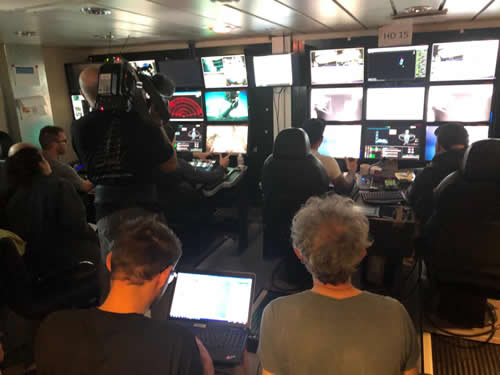 Filming in the ROV control room
Source: Michael Stocks Filming in the ROV control room
Source: Michael Stocks
 The team: Journalist Michael Stocks and camera man Thomas Aigner
Source: Nils Maschmann The team: Journalist Michael Stocks and camera man Thomas Aigner
Source: Nils Maschmann
|
|
MiningImpact Expedition Logbook, May 14, 2021 Blog #17: Nothing succeeds without logistics
One of the interlinked and complementary activities without which no expedition would succeed is logistics. It ensures that equipment, chemicals, consumables and all other necessary bits and pieces are onboard. Because in the middle of the ocean, the nearest hardware store is far away.
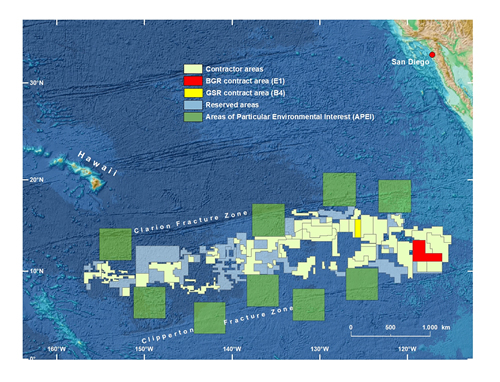 Map of the Clarion-Clipperton Zone in the tropical East Pacific with the contract areas of BGR (red) and GSR (yellow) and our port of departure in San Diego. Contract areas of other contractors are shown in light yellow and exploration areas relinquished by contractors to the International Seabed Authority are illustrated in blue-grey. Protected areas where no mining is allowed are marked in green
Source: BGR Map of the Clarion-Clipperton Zone in the tropical East Pacific with the contract areas of BGR (red) and GSR (yellow) and our port of departure in San Diego. Contract areas of other contractors are shown in light yellow and exploration areas relinquished by contractors to the International Seabed Authority are illustrated in blue-grey. Protected areas where no mining is allowed are marked in green
Source: BGR
Logistics start many months before the cruise begins. Here, at the latest, it becomes clear that the organisation of an expedition is teamwork. There are many important points to consider and to take care of. Some of them are:
- What is needed and in what quantities?
- What still needs to be bought and what are the delivery times?
- Where will the material be stored?
- What customs regulations have to be considered?
- Are only those things included that are on the packing list for customs?
- Is there airfreight in addition to container transport by ship?
- When does the freight have to be shipped so that it arrives at the port of destination on time?
- ...
If planning and execution are poor, the entire expedition can fail. However, even if the preparation is good, there are always factors beyond one's control. For example, the weather. Due to heavy snowfall and black ice, our containers almost could not be picked up by the shipping company from the BGR storage area in Hanover and transported to the port in Hamburg as planned. Only after hours of shoveling snow and scraping ice could the trucks leave. Moreover, on this expedition, of course, we additionally had to deal with COVID and its global effects. A container ship that was supposed to take our cargo was suddenly cancelled without replacement and the newly booked container ship was already several days late in Hamburg and then simply left five of our containers at the pier, so that they had to be rebooked again on another freighter! At the destination port of Los Angeles, a long traffic jam had formed due to congestion and COVID-related staff shortages. It therefore took about ten days before the ships were even allowed to enter the port.
Result: Despite a considerable time buffer of three weeks that we had planned for, the research vessel and we were there, but our equipment was not.
After the delayed arrival of the nine containers in total, they had to be unloaded and all the expedition equipment and working material had to be stowed in the laboratories, on deck and in three containers that we took with us on board the ISLAND PRIDE.
 Unloading the containers on deck of the ISLAND PRIDE
Source: Mirja Bardenhagen Unloading the containers on deck of the ISLAND PRIDE
Source: Mirja Bardenhagen
 Boxes with working material are stowed in the port of San Diego
Source: Mirja Bardenhagen Boxes with working material are stowed in the port of San Diego
Source: Mirja Bardenhagen
After everything has passed through the particularly strict US customs, hopefully without any problems, is loaded onto a cargo ship and has passed through the German customs back home, the containers will arrive back in Hamburg and finally in Hanover at the BGR in a few weeks' time.
There we have to unpack everything again and store it away for the next expedition.
After that work is finished, we can finally take a look at the samples collected in the Pacific Ocean.
Warm greetings from the tropics,
Mirja Bardenhagen
|
|
MiningImpact Expedition Logbook, May 14, 2021 Blog #16: GSR's collector test
There is increasing recognition that the world needs more metals than current supplies can provide. We need metal to meet the demands of a growing population and urbanization. For clean energy technology we need specific metals such as nickel, cobalt, manganese, and copper. Polymetallic nodules of the Clarion Clipperton Zone contain all of these. The world needs metal supply options and we are exploring one such option.
Intuitively, we think going to the deep seafloor for these metals could make a lot of sense from an environmental and social responsibility standpoint. Even so, we want to be sure we are collecting the minerals carefully, thoughtfully, and with care for the ocean environment front and center in our minds. We are ocean people too.
These 4 metals never occur all together in terrestrial mines and on land, you need 2 or 3 mines to produce them, as opposed to one nodule collection operation on the seafloor. On the seafloor, there are no trees or people that need to be moved and the math tells us collecting minerals from the seafloor can have a much-reduced carbon footprint compared with collecting the same minerals from land.
Global Sea Mineral Resources (GSR) has developed a pre-prototype nodule-collecting robot named Patania II and collaborated with independent scientists aboard the chartered vessel Normand Energy to monitor mining trials. These trials were also monitored from the MV Island Pride by independent scientists of the JPI-O MiningImpact Consortium, invited by the Federal Institute for Geosciences and Natural Resources (BGR). This is unprecedented and took a great deal of effort and co-ordination on all sides to ensure success (not to mention during a global pandemic). GSR is so proud to have been a part of this world-first and transparent effort and would like to thank BGR, JPI-O MiningImpact and all involved scientists for their dedication, expertise and professionalism.
The trial took place in the GSR (Belgian-sponsored) and BGR (German-sponsored) contract areas of the Clarion-Clipperton Zone (NE Pacific Ocean), from April to mid-May 2021.
Patania II was successfully operated at commercial driving speeds and nodule pick-up rates. For the GSR trial area, 171 x 50m-long lanes have been completed along 3 strips (55 lanes on strip 1, 31 lanes on strip 2 and 85 lanes on strip 3) in 40hrs (19-21 April). The total mined surface cleared from nodules is estimated at 30,899m². The track length driven was ~8,550m (8.5 km) and the total track length driven for all 4 Mining Strips (Mined Area + Lightbulb turns) was 21,375 m (21 km).
The second nodule collection trial (8-9 May), performed during a period of 24hrs, was also successfully achieved under challenging circumstances (e.g. Greenpeace protests). Patania II was able to perform 118 lines of 50m-long along one single strip. With a collector width of 4m-wide, the total mined surface area is evaluated to 23,600 m², for a total track length driven of 5,900m (5.9km).
The monitoring conducted on board the GSR vessel was performed in collaboration with the Massachusetts Institute of Technology (MIT) and the University of Ghent (MarBiol). The scientists used acoustic sensors (Acoustic Doppler Current Profilers [ADCPs], turbidity meters, and a particle settlement camera) and collected water samples with Niskin® bottles to evaluate the plume of re-suspended sediment in the near-field environment of the pre-prototype vehicle. These devices were mounted on the seafloor nodule collector to take the closest measurements. Oceanographic moorings with ADCPs and turbidity meters were also deployed to investigate the physical characteristics (concentration, grain-size, speed, altitude, etc.) of the medium-field sediment plume.
GSR acknowledges that before polymetallic nodule collection can occur at a commercial scale, it needs to be demonstrated that such activities can be managed to ensure the effective protection of the marine environment. The trial and studies will serve as a foundation for reliable modelling of commercial operations and will inform the next phase of engineering development as well as environmental management.
 The pre-prototype nodule collector Patania II during recovery
Source: GSR The pre-prototype nodule collector Patania II during recovery
Source: GSR
|
|
MiningImpact Expedition Logbook, May 13, 2021 Blog #15: The International Seabed Authority
Our expedition takes us into international waters, also called "the Area" and I am occasionally asked who issues the licenses for the exploration of mineral resources in that part of the ocean. Well, it's the International Seabed Authority, which is based in Kingston, Jamaica. The seabed beyond the limits of national jurisdiction, i.e. beyond the 200-mile zone, covers about 40 percent of the Earth's surface and is considered as the "Common Heritage of Mankind" according to Article 136 of the United Nations Convention on the Law of the Sea (UNCLOS). The International Seabed Authority (ISA) in Kingston, Jamaica, created in 1994, administrates this heritage. It is an autonomous international organisation with currently 167 member countries and the European Union.
 Headquarters of the International Seabed Authority in Kingston, Jamaica
Source: ISA Headquarters of the International Seabed Authority in Kingston, Jamaica
Source: ISA
The ISA is mandated under the UNCLOS to organize, regulate and control all mineral-related activities in the international seabed area for the benefit of humankind as a whole. In doing so, the ISA has the duty to ensure the effective protection of the marine environment from harmful effects that may arise from deep-seabed related activities. It also has the task of advancing the balance of interests between industrialised and developing countries. Since no deep-sea mining has taken place to date, the central task of the ISA is currently to draft the regulations for the future mining of mineral resources in the deep sea, in addition to issuing and monitoring exploration contracts.
 Plenarsaal der IMB während der 25. Sitzung in Kingston
Source: IISD Reporting Services Plenarsaal der IMB während der 25. Sitzung in Kingston
Source: IISD Reporting Services
Both state-owned institutes such as the BGR and private companies as Global Sea Mineral Resources can apply for an exploration contract for a fee of 500,000 US dollars. The applications must be endorsed by their home state, the so-called "sponsoring state". The sponsoring state verifies the applicant's compliance with the requirements defined by the ISA regulations as well as its financial and technical capabilities. Furthermore, the state is obliged to monitor and is liable for this activity. Since 2001, the ISA has concluded a total of 30 contracts to explore the seabed for mineral resources. So far, eighteen contracts for the exploration of manganese nodules in areas of 75,000 square kilometers each have been issued, five for the exploration of manganese crusts (3,000 sq. km each) and seven for the exploration of massive sulphides (10,000 sq. km each). The contractors are from twenty different countries, twelve of them from Asia, thirteen from Western and Eastern Europe, four from Pacific island states and one from South America. Another contract with a company based in Jamaica is still pending signature. Each exploration contract has a term of 15 years with the possibility of extensions of five years upon application. These contracts also grant a priority right to future mining licenses and - after an extensive environmental impact assessment - allows for the testing of technological equipment, for example for a mining collector, as is planned for the next few weeks in the Belgian and German contract areas.
Warm greetings from the Pacific Ocean,
Carsten Rühlemann
|
|
MiningImpact Expedition Logbook, May 13, 2021 Blog #14: The challenges of the box corer or the cold in the tropics
In the blue-red evening light, the three challengers stand in front of the white barrel of four-degree cold seawater. The coffee-brown sediment in the box corer shines as a bricklayer's shovel approaches and lifts off the first pieces to carefully slide them into the seawater. Three hands approach the water, slowly dipping first the fingertips and finally three forearms into the icy water and begin to stir gently. The sediment must be stirred up, but that really doesn't matter. The real question is: Who will be the first to give up and pull his hand out of the bone-chilling water?
We use the box corer to examine macrofauna. Macrofauna includes all tiny animals from the deep-sea sediment that are larger than 300 µm (0.3 mm); these are mainly bristle worms (Polychaeta) and various crustaceans such as isopods (Isopoda). Of course, since they live in the seafloor sediment at a water depth of 4500 m, we first have to bring them to the surface, and that's where the box corer comes in. It's basically a box of a quarter of a square meter in size that is lowered down to the seafloor and takes out a chunk of sediment. It is attached to a frame along with a shovel that closes as soon as the box corer hits the seafloor, preventing our deep-seabed sample from slipping out of the box on the way up to the sea surface.
More and more of the soft, fluffy surface sediment ends up in the cold seawater. The sediment isn't any warmer, either; after all, it's coming straight up to the deck from the deep sea where the temperature is only 1.5°C. All hands are still in the water, so far no one has given up. Meanwhile, the small pieces of sediment slowly disintegrate until a uniform brown mud soup is formed. The three arms stir slowly and steadily on and on. After all, we're talking about a can of Coke.
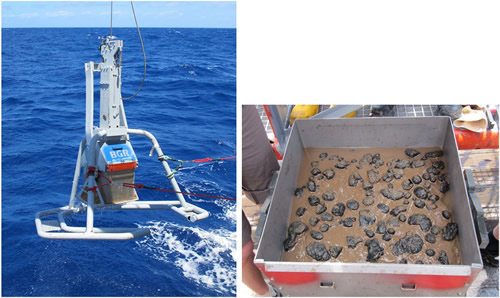 The box grab brings about a quarter of a square meter of deep-sea floor to the deck. We are interested in the macrofauna contained therein, i.e. all animals larger than 300 µm
Source: Sven Rossel The box grab brings about a quarter of a square meter of deep-sea floor to the deck. We are interested in the macrofauna contained therein, i.e. all animals larger than 300 µm
Source: Sven Rossel
Once the box corer has reached the vessel's deck and is secured, the first thing to do is to remove the box from the rack. Nuts and bolts are loosened, then the crate can be pulled out of the rack with a pallet truck. The first thing we biologists do is siphon off the water that is above the sediment in the box and let it run it through a sieve. We find a lot of small organisms in this water as well. The water in the box corer is almost always turbid. But slowly visibility clears and we can see the first manganese nodules. Now it gets exciting: Did we possibly catch one or two big animals? Maybe one of the gigantic single-celled organisms, called Xenophyphora, which stand guard like flowers on the manganese nodules? Is there a brittle star? Or even a sea urchin?
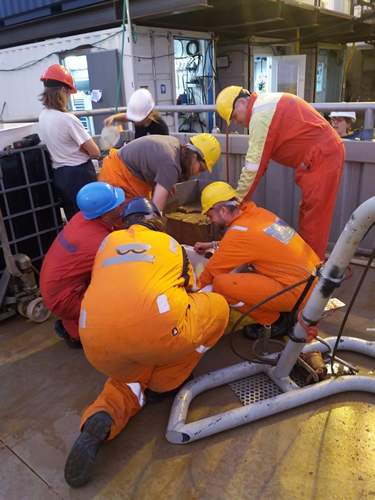 When the box grab is on deck, the sediment is shovelled into 4° cold seawater. In the water, it is suspended so that it can finally be sieved over 300 µm. This flushes out most of the sediment, making it easier to get the animals out of the sample
Source: Henko de Stigter When the box grab is on deck, the sediment is shovelled into 4° cold seawater. In the water, it is suspended so that it can finally be sieved over 300 µm. This flushes out most of the sediment, making it easier to get the animals out of the sample
Source: Henko de Stigter
The challenge continues, meanwhile the next layer is being removed from the box corer. All three guys are still on the job, while the top layer with the most animals is already being sieved through a sieve with a mesh size of 300 µm. Each handles the cold differently. One stoically stirs, the other one is joking and the third competitor curses the cold that floods that comes flooding back into the icy water with each new piece of sediment. But they are all still stirring.
Once the water is removed from the surface of the box corer, we can finally see what piece of seafloor we've brought to the surface. After taking a photo, we carefully take the manganese nodules off and rinse them in cold seawater. We also examine the nodules to identify the animals that live on their surface and in the narrow, sediment-filled crevices. Now, without water, we can unscrew one side of the box and look at the deeper sediment layers as well. However, we biologists are not really interested in the patterns of stratification. We always divide the box core sample into the same three layers, the top three centimeters, the following two centimeters, and a layer of five to ten centimeters. This is useful because most of the animals live in the top three centimeters, and we thus are aware of which groups of animals prefer the deeper sediment.
The three competitors have reached the last layer. Now the sediment is no longer soft but stickier and harder to disperse. However, the three guys continue to stir, carefully and evenly so as not to destroy the sensitive animals and also to avoid spilling the sample on the deck. Now more sediment is added to the icy water, the still cold layer from a depth of between five and ten centimeters. Meanwhile, the first layer is already prepared to be sorted in the lab. Now the next layer can be sieved.
By first suspending the sediment and then sieving it over 300 µm, we can screen out the fine deep-sea clay and keep the animals on the sieve. However, they still need to be picked out of the rest of the sediment. And even though macrofauna can often be seen with the naked eye, it is very difficult to see them among the remaining sediment grains and manganese nodule debris. That is why they are sorted under a microscope and divided into different groups of animals. For the best possible fixation of the animals without sediment, this is done immediately on board.
Meanwhile, the last layer of the box corer is ready to be sieved. The three competitors part with a draw and can warm up in the tropical evening air with an ice-cold coke. Nobody won, but all our samples from the box corer are secured and now the remaining, deeper sediment can be released for other purposes.
 The geologist Henko de Stigter regularly uses the remains of the box corer to create pieces of art like this mermaid
Source: Henko de Stigter The geologist Henko de Stigter regularly uses the remains of the box corer to create pieces of art like this mermaid
Source: Henko de Stigter
With best regards from aboard the ISLAND PRIDE
Katja Uhlenkott
|
|
MiningImpact Expedition Logbook, May 12, 2021 Blog #13: Catching trace metals at the seafloor
A day without new samples and well rested for the first time since 10 days – now is the right time to write a blog contribution. More than half of the cruise is already over, the boxes for samples are filling up one after the other. We are still in the Belgian contract area but will start our 2-day transit towards the east soon.
I’m Katja and I work as Geochemist at the Federal Institute for Geosciences and Natural Resources (BGR) in the department for Marine Resource Exploration. It is the third time for me that I spend several weeks here in the Central Northeast Pacific Ocean, an area where the seafloor in more than 4000 meters depth is covered by ore deposits called manganese nodules. This year’s cruise aims at monitoring and investigating the direct environmental impacts of a prototype mining vehicle operation at the seafloor that lasted for several days. I will look at it from a geochemical perspective, focussing on trace metals.
An anthropogenic release of trace metals that are naturally bound in the seafloor mud and in the manganese nodules is of concern when considering deep-sea mining. The collector activity leads to the formation of a particle-loaded plume of whirled-up sediment. The plume is dispersed with the currents at the seabed, and a mobilization of trace metals in these plumes may potentially impact the fauna. Many trace metals are essential micronutrients in the environment, but become toxic at elevated concentrations. Different uptake routes are possible: diffusion through cell membranes of organisms or uptake of metal-rich particles by filter-feeding organisms. For assessing the impact and defining threshold values it is of importance to not only know the absolute concentrations but also to understand in which physical and chemical form the metals occur. Furthermore, impacts on the natural cycling of elements in the water column and in the sediment are expected.
In the geochemistry team on board we are three people. Mirja (BGR), Matthias (GEOMAR) and myself are responsible to collect all relevant samples for later geochemical analyses. Components, such as nutrients, organic and inorganic carbon, alkalinity, physical sediment properties as well as the elemental composition, including trace metals, are essential variables that need to be determined. Our main working places to process the samples are the cold room at 4°C and the geochemistry lab. All scientific labs, including the cold room, consist of containers fixed on the outside deck and we better not forget something, before we switch from one location to the other. Before we go on deck, we need to dress up with our safety boots, helmets, and coveralls. In the cold room, we better wear warm clothes and a hat. In the laboratory container in turn, we leave all dirty clothes outside and wear lab shoes. Once our samples arrive on deck, they need to be processed immediately, which takes many hours. And in the meantime, the next samples already arrive… . Sometimes it feels like a never ending story. Few hours of sleep, often enough interrupted by the ringing phone … . But at least, our laboratory container has large windows so that we get daylight and a nice view. A little break in the sun, with afternoon cake and fresh coffee (Figure 1), also helps to refresh.
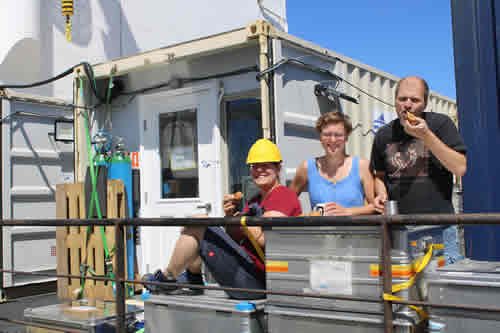 Coffee break in front of the geochemistry container, from left to right: Mirja, Katja, Matthias
Source: Annemiek Vink Coffee break in front of the geochemistry container, from left to right: Mirja, Katja, Matthias
Source: Annemiek Vink
As mentioned, we sample both, seawater and surface sediment. So, how does a typical work-flow look like once the samples arrive on board?
(1) For seawater trace metal investigations, the first challenge is to get the water samples without already contaminating them. Trace metals are not only in the water that we want to sample. May it be contaminants in tobacco smoke (such as rare earth elements cerium and lanthanum), dust particles in the air (copper, cobalt or zinc) or metal alloys (iron, cobalt and zinc) - metals are everywhere, just waiting to screw up our samples. As we don’t want to see any of these signals in our samples but only what is transported in the water, a successful trace metal project always starts with proper cleaning and proper sampling. For collecting the water, we use the special GoFlo water sampler bottles (Figure 1) that are designed for trace metal sampling, without any metal parts being in contact with the water. Once on deck, the sampled water is split and preserved for different purposes, while continuing to work as metal-clean as possible – which is a tough challenge on a ship made of steel (Figure 2).
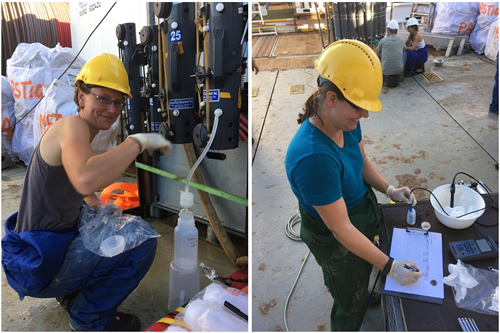 Mirja and Katja on deck, filtering water from the GoFlo water samplers and measuring pH and conductivity after a successful deployment
Source: Annemiek Vink Mirja and Katja on deck, filtering water from the GoFlo water samplers and measuring pH and conductivity after a successful deployment
Source: Annemiek Vink
On deck, we avoid any contact with air while collecting the water in different plastic bottles, and in the geochemistry laboratory, we work under clean air boxes, use ultrapure acids for preservation, and try to keep our lab as clean as possible – not a simple task at all. We filter the water samples to separate clay-, silt- and sand-sized particles and also the invisible nanoparticles from the water and finally, all samples are stored.
(2) The 30-cm long surface sediment cores are processed in the cold room. This is necessary to keep the in situ temperatures and not change chemical equilibria in the sediments. After taking pictures and describing the cores visually, we sample the sediment in 0.5-cm to 1-cm slices to obtain depth profiles (Figure 3). The vials with sediment are then brought to the lab, where we separate the pore water via centrifugation. We take different sample splits of the obtained pore water (Figure 4), do first measurements of sensitive parameters, and then preserve the samples by acidifying or freezing them. The analytical results will allow us to quantify how much of the surface sediment layer was removed by the collector machine and to characterize the quantity and quality of the material that has resettled from the plume. Biogeochemical processes in the sediment provide the basis for all life in and at the seafloor, and our work represents one of the puzzle pieces to understand the medium- and long-term impacts of deep-sea mining.
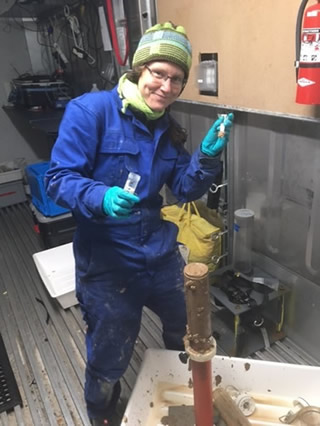 Katja in the cold lab (4°C), working on a 30 cm long sediment core from the seafloor
Source: Mirja Bardenhagen Katja in the cold lab (4°C), working on a 30 cm long sediment core from the seafloor
Source: Mirja Bardenhagen
|  Mirja filtering the extracted pore water from the sediment under the clean bench in the geochemistry lab
Source: Katja Schmidt Mirja filtering the extracted pore water from the sediment under the clean bench in the geochemistry lab
Source: Katja Schmidt
|
(3) In addition to bringing water and sediment on deck and sample it, we also use the method of in situ passive sampling, a really smart way to collect metals. A membrane hangs around in the water and attracts a specific part of a trace metal: that species which is not tightly bound to other components in the water and can be easily taken up by organisms (the so-called labile pool). Once these metals get close, they are “caught” and stick to the membrane. That’s why it is called passive sampling. The passive samplers collect metals constantly over time as long as they stay in the water. We mounted the small membrane holders onto the sensor platforms that were deployed at the seafloor for the time during and after the test to record the water turbidity at different distances and orientations to the test area (Figure 5, refer to sensor blog). As the passive samplers selectively collect those trace metals that can be taken up by organisms and hence be potentially harmful, we will here get more information on the bioavailability of the metals mobilized from the sediment that is whirled up from the seabed. Passive samplers are further a promising tool for long-term monitoring purposes, as they can be deployed in situ and minimize metal contamination during sampling and sample treatment on board and in the home laboratory.
 Passive sampler membranes: membranes attached to a sensor platform that has been wraped in clink film
Source: Katja Schmidt Passive sampler membranes: membranes attached to a sensor platform that has been wraped in clink film
Source: Katja Schmidt
| 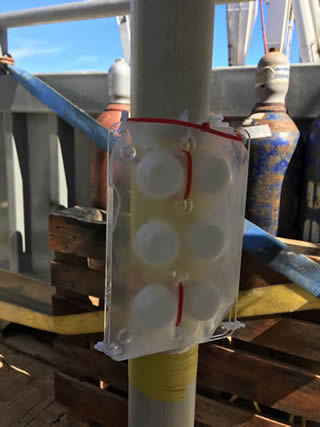 Passive sampler membranes: membranes attached to the frame of a sediment trap, still covered by clink film to protect them from dusty air
Source: Katja Schmidt Passive sampler membranes: membranes attached to the frame of a sediment trap, still covered by clink film to protect them from dusty air
Source: Katja Schmidt
|
As the passive samplers selectively collect those trace metals that can be taken up by organisms and hence be potentially harmful, we will here get more information on the bioavailability of the metals mobilized from the sediment that is whirled up from the seabed. Passive samplers are further a promising tool for long-term monitoring purposes, as they can be deployed in situ and minimize metal contamination during sampling and sample treatment on board and in the home laboratory.
All the best from MV Island Pride,
The geochemistry team (Mirja, Katja, and Matthias)
|
|
MiningImpact Expedition Logbook, May 11, 2021 Blog #12: A lab rat on tour
Not many lab rats, such as myself, can join a seagoing expedition. This is my second trip. The first was an expedition to the North Sea, on our very doorstep, you might say. This one is between Mexico and Hawaii in the Pacific Ocean. So it's a bit further away. Since we are sailing in Covid-19 times, the preparations were really a nightmare. However, I don't want to expand on that. Let's just start at the airport in Frankfurt. Most of the scientists took the same flight to LA. The journey itself was quiet and, after all, very long with its 12 hours. When we finally arrived, we met other researchers from other countries and took a bus together to a hotel in San Diego, some 120 kilometers south of LA airport. In this hotel, we spent the following 12 nights in single rooms in self-isolation. Fortunately, each room was equipped with a small balcony and we saw each other during daily online meetings. Even an online sports and an online games group were formed.
 Lab rat on the balcony in the hotel and at the PC
Source: Mirja Bardenhagen Lab rat on the balcony in the hotel and at the PC
Source: Mirja Bardenhagen
When we finally went onboard the vessel, many of our containers had not yet been delivered. They arrived only one by one during the following days, nevertheless there was a lot of activity onboard the ship. Standing on the upper deck, it sometimes resembled a startled anthill. Where do we store all our equipment and aluminium boxes?
 Lab rat on an aluminium box
Source: Mirja Bardenhagen Lab rat on an aluminium box
Source: Mirja Bardenhagen
Therefore, I decided to go to my cabin for a while. However, here I had the same issue. On vessels equipped for scientific expeditions there is not much space in a cabin and usually you share it with another person.
 Lab rat in upper bunk
Source: Mirja Bardenhagen Lab rat in upper bunk
Source: Mirja Bardenhagen
Onboard, the sports and games groups finally met face-to-face and the sports group could do their exercises on the helideck with a fantastic view.
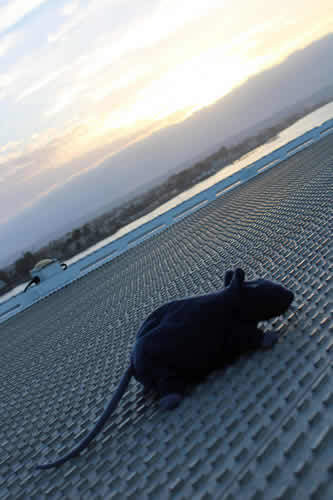 Lab rat on helideck
Source: Mirja Bardenhagen Lab rat on helideck
Source: Mirja Bardenhagen
After 5 days, we received the remaining containers and were able to store and secure our equipment. In the evening, we finally set sail. However, the Pacific Ocean welcomed us with waves of more than 3 meters height. Even a water rat gets sick sometimes.
The daily work routine is completely different to the one in our home labs, but on the other hand it is somehow similar.
 Lab rat on the Clean Bench in the geochemistry lab container
Source: Mirja Bardenhagen Lab rat on the Clean Bench in the geochemistry lab container
Source: Mirja Bardenhagen
For example, measuring the pH of a water sample is the same as in the laboratory on land. However, on land I don't have to be aware that the ground moves. At least not where I live. However, the view from a ship is much more impressive.
 Lab rat watching the sunset at sea
Source: Mirja Bardenhagen Lab rat watching the sunset at sea
Source: Mirja Bardenhagen
Something else that's very different, even from everyday life of a ship, is the company of two journalists. Even though we are all used to having photos taken with our smartphones all the time nowadays, it is something else to have a professional camera looking over your shoulder ;-)
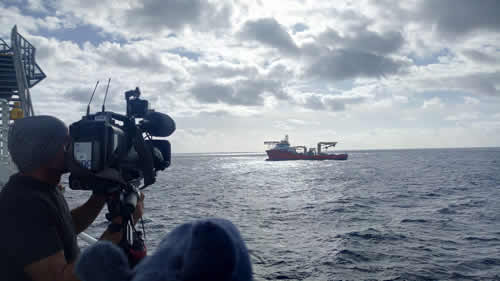 Lab rat looking over the shoulder of cameraman Thomas Aigner
Source: Mirja Bardenhagen Lab rat looking over the shoulder of cameraman Thomas Aigner
Source: Mirja Bardenhagen
It's not only the work that's different from the office at home. A ship is like a small self-sufficient city. Besides the working areas such as the bridge, engine room, main deck, galley (kitchen), laundry and the living area where the cabins are, there is also a recreation room, a sports room and a sauna.
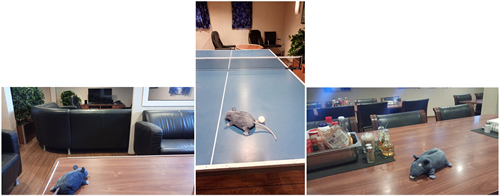 Lab rat in the recreation room, on the TT-board and in the mess
Source: Mirja Bardenhagen Lab rat in the recreation room, on the TT-board and in the mess
Source: Mirja Bardenhagen
These different compartments of a ship are all necessary when you consider that we will be sailing alone on the Pacific Ocean for six weeks. Well, almost alone.
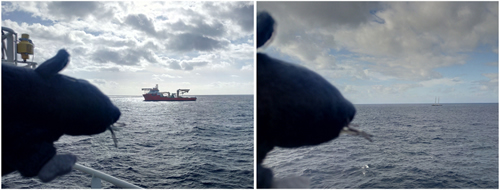 Lab rat discovers other ships
Source: Mirja Bardenhagen Lab rat discovers other ships
Source: Mirja Bardenhagen
Furthermore, there are many other animals, such as flying fish and squid or mahi mahi, creatures that a landlubber usually never gets to see. An eagle visiting us on the helideck in the harbour of San Diego was also very impressive.
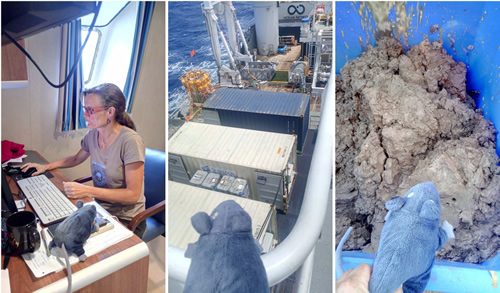 Lab rat visiting chief scientist Annemiek Vink. Lab rat looking at the main deck and examining the remains of the seabed
Source: Mirja Bardenhagen Lab rat visiting chief scientist Annemiek Vink. Lab rat looking at the main deck and examining the remains of the seabed
Source: Mirja Bardenhagen
Warm greetings from the Pacific Ocean
Mirja Bardenhagen
|
|
MiningImpact Expedition Logbook, May 10, 2021 Blog #11: Microbes are everywhere, so are we!
It is four in the morning on main deck of Island Pride; Massi has found me among the people who are taking samples from Niskin bottles which came on deck recently, and said: “I’ve just finished the in situ pump sampling; after sleeping a couple of hours I could take care of samples from the multicorer, then I could start with nodules from the box corer. Once Jakob finished the assays for extracellular enzymatic activities, could you please start slicing the cores? I guess filtration of the seawater from the last CTD would be completed until that time. Then, if Felix and Duygu finished their job with the oxygen profilers; we can discuss water sampling and push core plan for the upcoming ROV dive”. It may sound exciting and the same time chaotic (maybe it does not make much sense for many of the readers…). For us it is more an issue of clever sleep-deficit management.
In fact, these activities have become the routine for the last two weeks, as well as the 6-8 hours of sleep at night replaced by a nap when the opportunity arises. Yet, the tiredness is always accompanied by a smile and an attentive gaze, reflecting a strong motivation to achieve the goals of the expedition. Our team from HGF MPG Joint Research Group for Deep-Sea Ecology and Technology, of Alfred Wegener Institute and Max Planck Institute is prepared and trained for these working conditions. In fact, awareness of the challenges and the importance of this project for safeguarding the deep sea encourages us to make the best use of time and sampling activities on board of Island Pride.
 Nobody in the Microbiology Container? They might be in the cold lab if they are not hurrying to the muster station for a safety drill
Source: Batuhan Yapan Nobody in the Microbiology Container? They might be in the cold lab if they are not hurrying to the muster station for a safety drill
Source: Batuhan Yapan
As mentioned on previous posts in more detail, the aim of the expedition is to assess the impact of a polymetallic nodule prototype collector Patania II on the deep-sea ecosystem. In order to evaluate the type and the extent of the impacts we followed the mining operations of Patania II closely, monitoring the behavior of the sediment plume created by the collector, and collecting samples from the plume, the tracks left by Patania II, and from close-by sites where suspended sediments resettled. The task of our group is to assess the impact of mining operations on microbial abundance, diversity and metabolic activities. Although invisible to the human eye, microbes (which includes Bacteria and Archaea) typically constitute the largest proportion of the biomass in deep-sea sediments and play important roles in carbon and metal cycles. They are therefore crucial for the function of the largest, yet largely unexplored, ecosystem on Earth. Elucidating the microbial diversity and their functions in the deep sea requires combined studies of the interlinked microbial communities in bottom waters, sediments and polymetallic nodules. This is why the microbiology team onboard has to take samples from every type and each deployment, and apply different analytical methods.
I guess by now you may be confused enough by terms such as CTD, Niskin bottle, ROV, multicorer, core slicing, in situ pump… So let’s try to clarify what, how and why we are collecting/doing here.
Water samples are taken just above the seafloor with special plastic containers, called Niskin bottles, attached to a metal frame equipped with several sensors measuring temperature, oxygen, salinity and turbidity. The heart of this instrument is the CTD that measures Conductivity (used to calculate salinity), Temperature, and Depth plus – in its current configuration – oxygen and turbidity. The latter sensor is specifically important in this project as it allows identifying the presence of the sediment plume, which increases the water turbidity. Water samples are used to investigate the taxonomic diversity (via the extraction of DNA), microbial cell abundance and the amount of organic carbon (as a proxy for the food availability). The seawater is also used for incubation experiments, which measure metabolic rates such as oxygen consumption (respiration), potential degradation of organic carbon (via extracellular enzymatic activities) and biomass production (via incorporation rates of specific substrates). Additional sampling devices are the in situ pumps: those specially designed pumps are programmed to filter hundreds of liters of seawater directly at the bottom of the ocean (that’s why “in situ”), providing therefore enough microbial biomass for extraction of RNA (yes, the same type of molecule used to produce COVID-19 vaccines!) which allows us to study the microbial physiology under natural condition. In this cruise, we were able to catch sediment plumes created by Patania II and take samples, which will allow evaluating the effects on microbial communities and their activity in the water column.
 Filtration setup; an old but still useful way to study microbes in the water. “FISH” on the labels has nothing to do with real fish. It is abbreviation of a cool cell visualization technique: Fluorescent In Situ Hybridization
Source: Batuhan Yapan Filtration setup; an old but still useful way to study microbes in the water. “FISH” on the labels has nothing to do with real fish. It is abbreviation of a cool cell visualization technique: Fluorescent In Situ Hybridization
Source: Batuhan Yapan
Sediments samples, located more than 4 km below the ship (!!!) were collected with the multicorer: as suggested by the name, it is a metal frame equipped with several plastic cylinders, that we call “cores liners”. These penetrate vertically in the seafloor getting undisturbed, approx. 30 cm long cores of sediment. Once on board these sediment cores are horizontally cut in different sections from the top to the bottom. This ‘slicing’ of the cores allows getting separate layers of sediment to study features at high resolution and to resolve the patterns along sediment profile. For this expedition, we increased the resolution of sediment slicing in order to detect the exposure of deep sediment layers, due to the removal to top sediments by the prototype collector, and the layers of sediment that resettled from the plume to the top of seafloor near the collector-trial area.
 Fate of a sediment core: to be sliced to different depth levels and put into tubes for further analyses. Which requires hours of work in a cold and noisy lab; some see it as a nice chance to hide from hot tropical afternoons
Source: Batuhan Yapan Fate of a sediment core: to be sliced to different depth levels and put into tubes for further analyses. Which requires hours of work in a cold and noisy lab; some see it as a nice chance to hide from hot tropical afternoons
Source: Batuhan Yapan
Nodules, potato-shaped mineral concretions lying at the top of the seafloor, are the targets of deep-sea mining in the Clarion-Clipperton Fracture Zone, due to their valuable metal content. However, for us they are more unique habitat features that provide hard substrate for sessile animals and host specific communities of microbes. Yet, little is known about the function carried out by microbes associated with the nodules and the role that microbes have in nodule formation. One important goal of our project is to disclose microbial diversity and understand which processes could be lost by nodule exploitation. In order to do that, nodules were collected in many areas and subsampled for DNA and RNA sequencing, cell counting, and metabolic measurements. We therefore sample three different parts: the surface exposed to seawater, the internal core, and the bottom layer that is in contact with sediments. Nodules were collected with a box corer: an effective sampling tool for larger amounts of sediments as compared to the multicorer, yet a bit rougher and more basic.
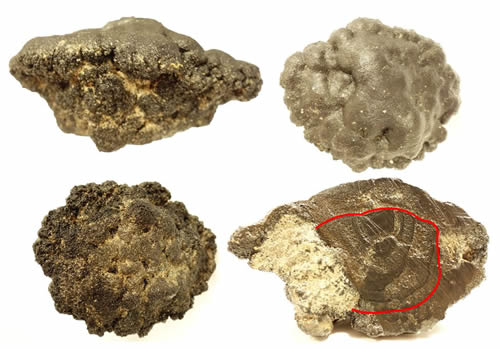 A closer look at a manganese nodule and its parts. As clearly seen manganese nodules are not homogeneous structures, they have different parts with different characteristics
Source: Massimiliano Molari A closer look at a manganese nodule and its parts. As clearly seen manganese nodules are not homogeneous structures, they have different parts with different characteristics
Source: Massimiliano Molari
By measuring the oxygen distribution in the sediment one can calculate the rates of oxygen uptake as a measure of the activity of the organisms living in the sediment and their uptake and use of organic carbon. For that job we have on another “in situ” exciting tool: the oxygen profilers. Basically, they are very cleverly designed needle-shaped sensors that penetrate into the sediment and measure oxygen concentration based on changes in oxygen-reducing current or fluorescence of oxygen-sensitive dye. Although the principle is pretty simple, running them at thousands of meters of depth is not easy, especially if there are nodules waiting to break the fragile needles. That is why Duygu and Felix spend hours in their lab/workshop hybrid to calibrate new needles and maintain the profilers before they move on to the control room to see their tools being deployed at the seafloor (hopefully with sensors pointing at gaps between nodules) by a robot (ROV) piloted by a skilled TOP-GUN team of the deep sea! However, results are worth the effort. By now, we have collected enough profiles to understand the oxygen consumption of microbes and are able to calculate oxygen flux and carbon metabolism. Also, profiles collected after the Patania test clearly deviate from undisturbed profiles and will be valuable to characterize the disturbance and document short-term effects on oxygen distribution and fluxes. We are keen to compare these results to modeling predictions of the effects of the removal of the active surface layer and deposition of oxygenated sediments from the plume.
 The lab where oxygen profilers are prepared to work under 4 km of water
Source: Batuhan Yapan The lab where oxygen profilers are prepared to work under 4 km of water
Source: Batuhan Yapan
The title of this long post is “Microbes are everywhere, so are we” - just in case you were patient enough to read until here, and forgot the title. When I decided on it I was thinking about our microbiology team’s hard work onboard, and our rush to take samples from every type and each deployment. When I thought a bit deeper, I noticed that we, humankind, are here thanks to microbes. They are everywhere and they have run this planet for billions of years, they are the organisms that keep it as a habitable planet, a unique one (as far as we know) in an infinitely big Universe. Just like microbes, we as humankind are also on our way to be everywhere; so, we need more and more resources. It looks like deep-sea mining is our next stop for these resources, but we have to be cautious and watch our impacts on ecosystem carefully, and we should take what we need with minimum negative impact. If we lose against our greed, we will be one of the first species that will be swept from this planet. Microbes? I do not worry about them too much; they will survive and continue to be everywhere, just as told in the quotation from Kurt Vonnegut’s Galapagos: “Truth be told, the planet’s most victorious organisms have always been microscopic. In all the encounters between Davids and Goliaths, was there ever a time when Goliath won?”
From here Gabriella will bring you to the borders of living being and will talk about the archenemy of life! VIRUSES!
Batuhan Cagri Yapan
PhD student at Max Planck Institute for Marine Microbiology, Bremen
The perfect deep-sea “gentlemen” killers
Yes, this is true, Bacteria and Archaea are everywhere, and they will survive, no matter what. As David, they are tough guys. But, would you believe me if I told you that the deep sea, as well as any other ecosystems on the Earth, hosts biological entities even smaller than microbes, whose sole purpose is to kill the winner (“Davids”)?
These natural born killers are the viruses. Viruses are present everywhere, wherever there is life, viruses are present. Especially now, everyone has experienced how huge the impact of these tiny units of proteins and nucleic acids can be on global human society… However, in this case there is nothing to worry about, as far as we know, deep-sea viruses are no danger for humans; their favorite hosts are the Bacteria and Archaea. As I said, these intriguing particles are far smaller than bacteria (from 20 nm to 250–400 nm), but 10 to 100 times more abundant. Just to be clear, imagine the sky during the darkest of all the nights, with no clouds and with bright stars as far as your eyes can reach, well, viruses in the Ocean are even more abundant than all those stars and, if your imagination is strong enough, you can think of stretching end to end all the viruses present in the ocean, they would span farther than the nearest 60 galaxies.
You all think now: “Wow viruses are so cool!”, don’t you? They are not even living organisms, they cannot “eat”, “reproduce”, and they even cannot “die”. Just think about a protein envelope (the capsid) enclosing viral genetic material (viral DNA or RNA) which contains all the information the virus needs to replicate and re-assemble himself within the cellular host, this is more or less a virus, as simple as that! The most abundant and fitful microbes are the first to be infected. And once infected, these wealthy bacterial (or archaeal) cells have only a little chance to survive, and they will end up as “cellular debris soup” (plus the new viral offspring, of course). A delicious soup I would say. Indeed, in deep-sea sediments the amount of organic resources is extremely low, and mostly composed of refractory compounds. Therefore, cell contents released after viral lysis can be seen as nutrient-rich food ready to be assimilated by non-infected cells (a process termed “viral shunt”). In other words, by killing their hosts viruses provide a delicious Italian lasagna for the starving microorganisms inhabiting the deep-sea sediments: so let’s see them as the Robin Hood of the deep sea, yet without that sweetened and romantic veneer!
Many cells are on their consciences. Viruses are responsible for the abatement of 80% of prokaryotic cells produced in deep-sea sediments (I told you, they are perfect “gentlemen” killers), releasing on global scale from 0.37 to 0.63 Gt of carbon per year. This process can contribute to around 35% of the total benthic prokaryotic metabolism in deep-sea sediments. I would say viruses are not only cool, but also important for deep-sea ecosystems. In fact, viral infections can control both microbial abundance (by killing them) and metabolism (by stimulating microbial growth with delicious free food).
As Batu has already mentioned, one day, we might really need deep-sea metal resources; as bad as it sounds, this could be the future. However, exploiting those resources in a responsible way is mandatory, and to know how to do that we need a scientific approach. This is the moment of “never before”, this is the cruise which allows us for the first time to study the consequences of a deep-sea mining impact on the seafloor before it will take place. As research team, at the Polytechnic University of Marche, in Ancona, we study deep-sea sediment worldwide to investigate virus-host interactions, the role viruses play in ecosystem functioning and human-induced impacts of this extreme ecosystem. The questions we would like to answer here are simple but tricky: how will viruses cope with disturbed seafloor? Moreover, if viruses are important in the functioning of deep-sea ecosystems, what will be the consequences on the deep-sea if virus-host dynamics are altered after mining impact? As of yet, we have no answers for that. My aim onboard is to preserve and process the samples collected here to respond to these questions. How do I do that? I have been trained to collect sediment samples from the multicorer and to slice them in layers of different thickness to estimate viral abundance in each layer of the core. However, measuring viral abundance alone is not useful for inferring viral dynamics into the sediments. Therefore, to assess viral impact on their hosts, and to understand the role of viral shunt in benthic food webs and carbon cycle, I also perform analyses of viral production (meaning how many viruses are produced for each gram of sediment per hour). Taken all together, these results will investigate how deep-sea mining can modify virus-prokaryotic interactions and which will be the downstream effects on ecosystem functioning.
 Our microbiology group on board. From left to right: Massimiliano Molari, Batuhan Yapan, Felix Janßen, Dyugu Sevilgen, Jakob Barz, Gabriella Luongo
Source: Nils Maschmann Our microbiology group on board. From left to right: Massimiliano Molari, Batuhan Yapan, Felix Janßen, Dyugu Sevilgen, Jakob Barz, Gabriella Luongo
Source: Nils Maschmann
Gabriella Luongo
PhD student a Polytechnic University of Marche, Ancona, Italy
|
|
MiningImpact Expedition Logbook, May 4, 2021 Blog #10: The AUV of the MANGAN 2021 expedition: What a beast!
Sensors are on the seafloor, Patania II is making a loop, but how can we see what is happening in real-time? Mando is doing the job for us! The Hugin Autonomous Underwater Vehicle (AUV) that we have onboard the MANGAN 2021 expedition, and lovingly named Mando, is capable of flying independently from the ship for kilometers in water depths up to 6 km, for several days (up to 90 h in our case), carrying many different sensors.
 Happy scientists in the AUV hangar (from left to right: Jochen Mohrmann, Iason-Zois Gazis, Karl Heger)
Source: Jochen Mohrmann Happy scientists in the AUV hangar (from left to right: Jochen Mohrmann, Iason-Zois Gazis, Karl Heger)
Source: Jochen Mohrmann

| 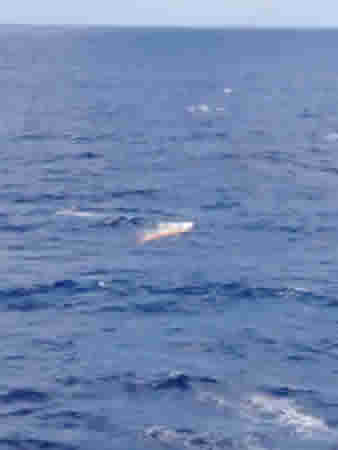
| Mando ready for its first dive during the IP21 expedition (left) and its ascent 60h later (right)
Source: Iason-Zois Gazis |
One of them is the WetLab FLNTU optical turbidity sensor that provides us with valuable information regarding the plume concentration and dispersion in real-time. We combine this information with the Multibeam Echosounder (MBES) data, in particular the echo signal from the particles in the water. The stronger the signal – the more sediment in the water. By moving around the impact area in a circle at different heights (5, 10, 30, 50 m) we get an idea of the plume development. After Patania II finishes its job, Mando moves on to collect data in areas further away. These data will show us how fast the plume moves in distances up to 5 km from the mining site.
The sediments inside the plume will eventually settle down onto the seafloor, covering the nodules. Mando performs two photo surveys: Before Patania II even touches the seafloor, Mando was there performing a pre-impact photo survey to create a high-resolution photomosaic. This is followed up by a post-impact photomosaic. Comparing these two photomosaics shows the extent and magnitude of this blanketing in centimeter resolution. While this may sound like an easy task, this mission was complicated by some factors: The navigation has to be super accurate at a distance of 5 m above the seafloor. While we are performing the mission, other activities are taking place from two vessels simultaneously, requiring us to react to changes at a moment’s notice. We were used to having the AUV mission to be 100% predefined. Now we make quite some use of the new abilities the HUGIN AUV provides – changing plans during a mission. We use this to avoid potential overlap and collisions with mooring deployments, CTDs and ROVs. Quite a 4D obstacle course!
 Pre-Impact AUV photo (raw) of the seafloor in the mining area
Source: GSR Pre-Impact AUV photo (raw) of the seafloor in the mining area
Source: GSR
All of this data is still just point data in a multidimensional space. The complete picture is only visible by integrating the data into a plume model. And in order for such a model to work properly, we need high accuracy topographic data. Yet another task our Mando is perfectly equipped to achieve with the integrated MBES and Side Scan Sonar (SSS). It allows us to create a one meter scaled bathymetric map of the broader area and an even higher resolution map of the directly impacted area.
 High-resolution multibeam barthymety of the broader study area, overlying on top of the ship-based bathymetry that was obtained during RV SONNE cruise SO268 in 2019
Source: High-resolution bathymetry: GSR; ship-based bathymetry: MiningImpact, SO268 High-resolution multibeam barthymety of the broader study area, overlying on top of the ship-based bathymetry that was obtained during RV SONNE cruise SO268 in 2019
Source: High-resolution bathymetry: GSR; ship-based bathymetry: MiningImpact, SO268
But Mando doesn’t stop there. It uses its “supervision” to look below the seafloor in the form of sub-bottom profiling (SBP), revealing different sediment layers underneath the seafloor.
In total Mando spend 260 h on the seafloor, tirelessly collecting terabytes of data that we now have to deal with. Thank you Mando!
Greetings from ISLAND PRIDE,
Iason-Zois Gazis, Jochen Mohrmann, Karl Heger
|
|
MiningImpact Expedition Logbook, April 30, 2021 Blog #9: Hunting the sea cucumber
Imagine, you sit in a large, dark room with a lot of screens at the wall. In the front part is a control panel similar to control panels in science fiction movies and two chairs for the pilots. Behind these ones is another row of chairs for us scientists. This is the ROV control room where the remotely operated vehicle (ROV), a type of deep-sea robot, is operated. Controlled by two pilots, this ROV can dive to the abyssal plains of the deep sea at 4,500 m where the pressure is too high for any human diver. Still, on the screens you can observe a lot of life at the seafloor. The animals that you can spot are several centimeters in size and mainly consist of fishes and invertebrates.
 Control panels and screens in the ROV operation room
Source: Sven Rossel Control panels and screens in the ROV operation room
Source: Sven Rossel
 The ROV is put into the water from the MV ISLAND PRIDE
Source: Nils Maschmann The ROV is put into the water from the MV ISLAND PRIDE
Source: Nils Maschmann
During this research cruise, we want to investigate how these different animals are effected by the sediment plume that Patania II creates while it collects the nodules. Our colleagues at home in Portugal and in Belgium focus on specific animals for their investigations and therefore they gave us lists of which animals they would like to study. Hence, during the ROV dives we try to collect brittle stars, sea cucumbers, sea anemones, and soft corals.
 Picture of the seafloor in the Belgian license area taken with an autonomous underwater vehicle (AUV). The letters belong to the following animals: A) fish, B) sea cucumber of the family Mesothuriidae, C) squat lobster, D) brittle star, E) sea anemone
Source: GSR Picture of the seafloor in the Belgian license area taken with an autonomous underwater vehicle (AUV). The letters belong to the following animals: A) fish, B) sea cucumber of the family Mesothuriidae, C) squat lobster, D) brittle star, E) sea anemone
Source: GSR
Today, we are hunting sea cucumbers. Sea cucumbers can swim, so that we use the “suction pump” or “slurp gun”. This tool works similar to a vacuum cleaner. You can suck up the whole sea cucumber like you would suck up a large spider at home, in case you are afraid of spiders. The sea cucumber is subsequently stored in a chamber in the ROV and you can retrieve it when the ROV is back on deck. That is how it should work, but today the sea cucumber is really fat. It just does not fit through the opening of the slurp gun (around 5 cm diameter). The ROV pilots carefully turn the opening of the slurp gun over the biobox, i.e., a large box inside the drawer of the ROV where biological samples can be stored. When the pilots turn off the slurp gun, the sea cucumber slowly sinks downwards into the biobox. Successful catch! But for a valid scientific study we need more specimens; so, the hunt continues.
 Sea cucumber of the species Deima sp.
Source: Nils Maschmann Sea cucumber of the species Deima sp.
Source: Nils Maschmann
Here in the Belgian license area of the Clarion-Clipperton Fracture Zone, most of the invertebrate megafauna consists of sea anemones and sea cucumbers, but we also already observed sea stars, brittle stars, sea urchins, soft corals, and sponges. Most of these animals have different life styles. Sea stars are often predators and chase other animals. In comparison, brittle stars and sea cucumbers are deposit feeders, i.e., they feed on sediment and on the organic matter in this sediment, and sea urchins feed more or less on everything they find. All these animals are mobile, hence they can move. However, there are also animals that are sessile, i.e., they sit attached to polymetallic nodules. These animals include sea anemones and soft corals, but also sponges.
 Sea urchin in a sample vial
Source: Nils Maschmann Sea urchin in a sample vial
Source: Nils Maschmann
The next animals we see through the camera in the deep blue are a brittle star and a sea anemone. Those are also high on our priority list! For brittle stars, however, slurping is not the best option. Instead, the ROV pilot uses the manipulator arm of the ROV and takes the animal very carefully in the claw of the robot.
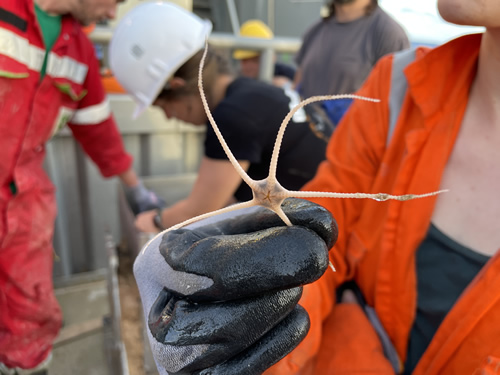 Brittle star in a box core
Source: Nils Maschmann Brittle star in a box core
Source: Nils Maschmann
Sea anemones and soft corals can best be scraped off nodules and be transferred into the biobox. Thus, we try to carefully collect the sea anemone. It does not want to go off, just retracts to a small, white ball, and sticks to its nodule. Our attempt to sample the animal creates a plume of soft sediment, hiding the sea anemone, the nodule, and the seafloor. Usually, when scraping the animals off their hard substrate does not work, you can also collect the whole nodule to which the sea anemone or the soft coral is attached and store it in the biobox. However, we decide to leave the sea anemone and continue to hunt another animal, instead of waiting until our sediment cloud has settled. Lucky sea anemone!
Greetings from ISLAND PRIDE,
Tanja Stratmann (Utrecht University, NL/ Max Planck Institute for Marine Microbiology, D)
|
|
MiningImpact Expedition Logbook, April 30, 2021 Blog #8: The copepod in the mud pile
Large animals can be recognized immediately. But besides the bigger and smaller animals, the mega- and macrofauna, there are the very, very small animals, that we call meiofauna. Although they always remain hidden from most people, they play an important role in the ecosystem and must therefore naturally be taken into account in our investigations. Due to their small size, working with these animals is often like the proverbial search for a needle in a haystack, because these tiny animals spend their lives in the seafloor. And looking for them there among the grains of sand can bring back old sandbox memories.
While megafauna can easily be captured with cameras and macrofauna can at least still be perceived with the naked eye, with meiofauna we are talking about microscopically small creatures with a size between 32µm and one millimeter. Unfortunately, this means that we can only search for them indirectly on board by sampling their habitat, the deep-sea sediment, and taking it back to our home institutes to study the animals there. On board, this often makes it look to bystanders like we're just playing with mud the whole time, and we get to listen to a lot of "funny" remarks.
But let's start with how we get our samples. Our sampling device is the Multicorer (MUC). It is equipped with 20 tubes, which are driven into the sediment by the dead weight of the MUC after more than two hours of descent to a depth of 4500m. After a short time, the MUC is then pulled out of the seafloor again, lids automatically shut from above and below, closing the tubes to secure the samples. These now make the two-hour journey back to the sea surface, where they are already eagerly awaited. The deployment and retrieval of this large-scale equipment on expedition is one of the more action-packed tasks in the life of a biologist: If you usually spend a lot of your time at the microscope, the computer or in the lab, you finally get to really lend a hand, and when you're working on the edge of the ship, there's a hint of danger that gets your pulse racing.
 Cofocal laser scanning microscopy images of different copepod species from the sediment of area of investigation
Source: Katja Uhlenkott Cofocal laser scanning microscopy images of different copepod species from the sediment of area of investigation
Source: Katja Uhlenkott
Once the MUC is back on deck, however, there is no time to calm down. Now the battle for the best samples begins. Sometimes it resembles a Mexican standoff: Whoever gives in first loses out and has to settle for a less than perfect sample. It is not uncommon for overhasty scientists to try to grab a sample and rush off with it, only to be stopped by the others just before reaching the lab. Fortunately, on this trip we agreed before sampling who would get which tubes of the MUC, so people are content to take lesser samples to keep the peace. As a rule, however, no one gets away empty-handed. If one had bad luck with the "blind" sample allocation, there is always someone who agrees to share a sample or spare an entire tube. The MUC samples are in great demand because not only we meiofauna researchers are interested in them, but also the geochemists and microbiologists, so that everyone always hopes that all samples reach the ship intact.
 The multicore after being recovered from the depth of the ocean. The tubes are filled up half with sediment and half with water that was brought up from the sampling depth
Source: Nils Maschmann The multicore after being recovered from the depth of the ocean. The tubes are filled up half with sediment and half with water that was brought up from the sampling depth
Source: Nils Maschmann
Once the samples are distributed, the big slaughter begins. This is what we call the processing of the tubes filled with bottom water and deep-sea sediment, and it proceeds in a more or less orderly fashion, depending on the area of interest. While the geochemists, for example, remove centimeter by centimeter of the drill core and take several samples each time, we meiofauna researchers are a bit coarser and directly remove the top 5cm as a whole. This is where most of our animals are at home, because there is still enough food here. In the deeper layers, life in our size class is rare. But even packing in the top five centimeters often ends up with us smeared from top to bottom with deep-sea sediment and feeling like we've been transported back to sandbox days. But unfortunately, we can't do more with our samples on board than pack up the sediment for transport home. The animals have to be separated from the sediment by a large centrifuge and sorted under the microscope. What is still somewhat possible with the macrofauna, becomes a battle against the ship's motion and our own seaworthiness with the meiofauna.
 Slaughtering of a sediment core will inevitably result in the processing scientists getting covered all over with mud
Source: Carsten Rühlemann Slaughtering of a sediment core will inevitably result in the processing scientists getting covered all over with mud
Source: Carsten Rühlemann
The meiofauna is dominated by two major groups. On the one hand there are the nematodes (Nematoda) as the most frequent group and the copepods as the second most frequent group. The term abundant is by no means an exaggeration because a sediment sample that fills only about half of a 1 liter sample container can contain thousands of nematodes and hundreds of copepods. This sheer volume makes the analysis of meiofauna communities difficult and, more importantly, time consuming, as all animals must be counted and identified. In addition to a strong knowledge of species, this requires a great deal of time. Nevertheless, these organisms are an important part of the ecosystem and their habitat would also be altered by deep-sea mining. Therefore, we are studying the meiofauna communities from the deep-sea mud despite the great effort and trying to find out as much as possible about them. With possible deep-sea mining in mind, we are also particularly interested in whether there are other areas from which the animals could recolonize their destroyed habitat.
Greetings from ISLAND PRIDE,
Sven Rossel
|
|
MiningImpact-Expedition Logbook, April 29, 2021 Blog #7: Greenpeace always on the watch
From the onset of our research campaign until last Saturday, Greenpeace accompanied the Patania II collector test of GSR. The RAINBOW WARRIOR always stayed close to the GSR-chartered ship NORMAND ENERGY to observe what was happening, even though there is usually not much to see up here, as the test takes place 4.5 kilometres below our feet. It is not surprising that Greenpeace positions itself against deep-sea mining, and it is appropriate that the environmental organisation - like other NGOs - highlights the risks associated with potential future mining. Greenpeace has published information on the environmental impacts of deep-sea mining several times during recent months and years.
In doing so, they rely on research that is being carried out worldwide; including the findings of scientists working here on board the ISLAND PRIDE. They often emphasise that almost nothing is known about the impacts. The conclusion is therefore, that stronger efforts are required to understand what happens when manganese nodules are mined. This is particularly important, because the International Seabed Authority is tasked with drafting the regulations for the exploitation of seabed mineral resources, which should contain the highest possible environmental standards.
Independent scientific research accompanying industrial mining tests is an adequate and transparent way to gather the needed information on the impacts. It is somewhat surprising that Greenpeace fails to acknowledge our presence on site in their media campaign. Instead, they themselves presented evidence of a "significant disturbance" to the seabed ecosystem to the outside world last Thursday. The organisation had indeed announced in advance that they would analyse the impacts themselves. We had already wondered how they intend to manage this, as the technology for measurement and observation in the deep sea is expensive and complex and takes up an enormous amount of space on a ship, not to mention the heavy winches needed to lower the equipment to the seabed and bring it back on board.
 The NORMAND ENERGY, launching the Patania II manganese nodule collector, is observed by Greenpeace activists onboard the RAINBOW WARRIOR in the background (left)
Source: Mirja Bardenhagen The NORMAND ENERGY, launching the Patania II manganese nodule collector, is observed by Greenpeace activists onboard the RAINBOW WARRIOR in the background (left)
Source: Mirja Bardenhagen
Greenpeace New Zealand has now published a press release stating that they observed the manganese nodule collector being repeatedly lowered into the water and coming back up, surrounded by a large cloud of sediment as it was pulled out. They interpret this as a sign of significant disturbance. However, anything that has been on the seabed comes back up with a bit of sediment on its contact surfaces. This also applies, for example, to our scientific instruments. The mud of the seabed is simply so cohesive that it sticks to the instruments even on the long journey of several hours to the sea surface. When Patania II is brought on deck, the remaining seafloor sediment is washed off in the “splash zone”, leaving behind the brown cloud that Greenpeace observed. However, this is not problematic at this small scale and definitely not evidence of significant environmental disturbance. Nevertheless, a disturbance on the seabed has of course taken place, which was precisely the goal of the test.
 Photos of the seafloor taken just outside of the test area with the ROV HD14 before (left) and after (right) the collector test. A sedimentary cover is clearly visible on the previously uncovered nodules
Source: BGR Photos of the seafloor taken just outside of the test area with the ROV HD14 before (left) and after (right) the collector test. A sedimentary cover is clearly visible on the previously uncovered nodules
Source: BGR
We want to understand the impacts of possible future mining on the environment. Previous attempts to carry out disturbance tests have been too small-scale in terms of affecting a contiguous seabed area. For the first time, GSR's test offers us the opportunity to study these effects under sub-industrial conditions. Patania II, with a size of 1:4 compared to the envisioned industrial-scale mining robot, collected the nodules together with the surface sediment and its inhabiting fauna in a field of about 200 x 300 square-metres. The sediment was released through a type of exhaust into the bottom water and created a sediment plume that we are monitoring and tracking in great detail. Read the plume sensor team's post "Groping around in murky water" in our blog. Our preliminary observations show that the sediment plume generated by Patania II seems actually confined to the bottom water near the seafloor, roughly the lower 30 metres. We will be able to determine the exact height and particle concentrations as well as its spatial and temporal dispersion pattern once we have retrieved all our measuring instruments from the seafloor and analysed the data.
 Jolien Goossens of Ghent University and Massimiliano Molari of the Max Planck Institute for Marine Microbiology in Bremen take samples from the Rosette water sampler. With this device, we obtain samples from a water depth of 4500 metres for geochemical and microbiological investigations. In addition to the grey water bottles, a variety of different sensors is attached to determine the chemical and physical properties of the water and to measure turbidity and current speed
Source: Carsten Rühlemann Jolien Goossens of Ghent University and Massimiliano Molari of the Max Planck Institute for Marine Microbiology in Bremen take samples from the Rosette water sampler. With this device, we obtain samples from a water depth of 4500 metres for geochemical and microbiological investigations. In addition to the grey water bottles, a variety of different sensors is attached to determine the chemical and physical properties of the water and to measure turbidity and current speed
Source: Carsten Rühlemann
We work according to best scientific practice and will publish all data and scientific findings in databases and scientific journals after peer review. This will also include the images from the seabed that Greenpeace is demanding from GSR in its press release. However, the images alone do not tell us much. We can see that the nodules are gone, recognise the tracks of the collector and estimate how far the bottom currents have carried suspended sediments away and then redeposited them on the surrounding nodule habitat. On the long term, however, it is essential to analyse how ecosystem functions and structure, biodiversity, and species connectivity are affected and whether the fauna can inhabit those disturbed areas again. This requires sampling, combined with complex laboratory analyses and a subsequent evaluation of the geochemical and (micro)biological data. This takes many months or even years. And it is not sufficient to sample only once directly after the impact. Instead, we will return several times in the coming years and repeat the sampling to understand the response of the abyssal ecosystem to this impact. We already know from previous small-scale experiments that disturbances in the deep-sea are long-lasting. But which threshold values for industrial large-scale mining need to be defined to avoid significant harm to the environment? What are indicators of good ecosystem health in the abyss and what are the criteria for the designation of appropriate marine protected areas? We are of the view that scientific findings should guide the debate on these questions. And that takes time…
 Sven Rossel from the German Centre for Marine Biodiversity Research in Wilhelmshaven samples seafloor sediments obtained with a multicorer from a water depth of 4,500 metres (left). The samples are used to study the meiofauna, tiny animals with a size up to about 0.3 millimetres. In addition, the sediment samples are used for geochemical studies. Alizé Bouriat from the French Institute Ifremer in Brest collects meiofauna (animals with a size between 0.03 and 0.3 millimetres) and macrofauna (0.3 mm to 1 cm) for later DNA analyses (right)
Source: Carsten Rühlemann Sven Rossel from the German Centre for Marine Biodiversity Research in Wilhelmshaven samples seafloor sediments obtained with a multicorer from a water depth of 4,500 metres (left). The samples are used to study the meiofauna, tiny animals with a size up to about 0.3 millimetres. In addition, the sediment samples are used for geochemical studies. Alizé Bouriat from the French Institute Ifremer in Brest collects meiofauna (animals with a size between 0.03 and 0.3 millimetres) and macrofauna (0.3 mm to 1 cm) for later DNA analyses (right)
Source: Carsten Rühlemann
With best regards from aboard the ISLAND PRIDE,
Carsten Rühlemann, Annemiek Vink and Matthias Haeckel
|
|
MiningImpact Expedition Logbook, April 23, 2021 Blog #6: Groping around in murky water
As explained in the introduction to this blog series, the plume of sediment stirred up from the seabed by mining machines is one of the major environmental concerns regarding deep-sea mining. The stirred-up sediment will be carried away by currents and for some part settle out in areas adjacent to the actual mining site, burying seabed fauna or impairing their breathing and feeding functions, and mixing the scarce nutritious material that sustains deep-sea life with large amounts of inedible mud. How much sediment is mobilised in the mining process and how far it is dispersed over adjacent areas are questions that urgently need to be answered in order to assess the full extent of environmental impact of deep-sea mining
These questions are also what the IP21 Plume Sensor Team will address during the IP21 expedition. To do so, we brought an impressive collection of sensors of all sorts, to set up a sensor array on the seabed with which we will monitor the sediment plume stirred up by the GSR mining machine Patania II. We also have equipment from project partners who could not participate themselves in the expedition.
 The corner in the AUV hangar, which we claimed as working space for the Plume Sensor Team
Source: BGR The corner in the AUV hangar, which we claimed as working space for the Plume Sensor Team
Source: BGR
From the moment that we could access our equipment shipped by container or flown in by airfreight to San Diego, and had claimed a working spot on the ship, we have been very busy preparing all this material for deployment. 30 Turbidity sensors, 15 current meters, a sediment trap, a particle camera, a stills camera, 4 hydrophones - all to be mounted on platforms that will be placed on the seabed with help of the remotely operated vehicle (ROV) or by free-fall deployment.
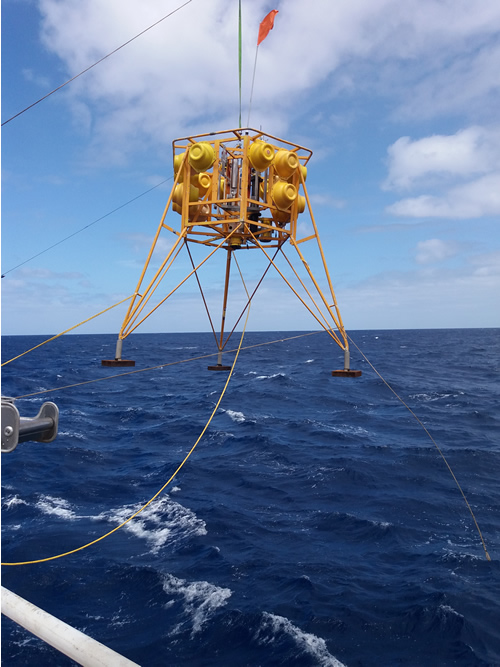 Launch of the BOBO lander
Source: BGR Launch of the BOBO lander
Source: BGR
The first platform which we deployed as soon as we arrived in the GSR contract area in the CCZ was the BOBO lander, a 4-m high tripod resembling a moon-lander. It was hoisted overboard and released for free-fall landing on the seabed. An acoustic beacon mounted on the lander allowed us to follow its 1.5 hour descent and touchdown on the ocean bottom 4500 m below our ship. During the subsequent days, the smaller sensor platforms were loaded into the subsea basket, an XXXXL steel shopping basket of 3.6 x 2.4 x 1.4 m weighing 3 tons, and lowered to the seabed. There, the two Schilling Heavy Duty ROVs of MV ISLAND PRIDE were used to take the platforms one by one from the subsea basket and distribute them around the 400 x 400 m area of seabed where the Patania II trial was going to take place. Working practically day and night, the last platform was placed on the seabed only hours before Patania II started its full-scale nodule collecting test.
 The subsea basket loaded with sensor platforms prepared for deployment on the seafloor
Source: BGR The subsea basket loaded with sensor platforms prepared for deployment on the seafloor
Source: BGR
 Karl and Jochen programming the Particle Camera platform of Jacobs University Bremen
Source: BGR Karl and Jochen programming the Particle Camera platform of Jacobs University Bremen
Source: BGR
 JUB’s Particle Camera dangling from a cable on the way to the seafloor, as seen by ROV HD14, and NIOZ sensor platform 03 firmly held in the robot arm of ROV HD14
Source: BGR JUB’s Particle Camera dangling from a cable on the way to the seafloor, as seen by ROV HD14, and NIOZ sensor platform 03 firmly held in the robot arm of ROV HD14
Source: BGR
Whilst some of us were sceptical about how far Patania II would come on its maiden trip on the Pacific Ocean floor, we must admit here that by distance driven, weight of nodules collected and volume of plume produced, the machine’s performance surpassed our expectations. The ROV HD14, busy with deploying a biological experiment at 500 m downslope from where Patania II had just begun the full-scale test, was suddenly overwhelmed by a dense cloud of suspended sediment that came rolling down the slope. Within seconds, the crystal-clear water made place for a murky soup in which visibility was reduced to less than a meter and manoeuvring only possible with help of the sonar. The acoustic underwater navigation system of the ROV was temporarily upset by interference caused by the dense sediment cloud. Groping around in the mist, the ROV incidentally stumbled upon one of the sensor platforms that had been deployed there in the days before. With the accurate seabed position of that platform known, the acoustic navigation could be reset, after which the ROV continued its designated tasks.
A day later, while flying the ROV close to the seabed in the surroundings of the Patania II collector test area, we observed that the plume had drifted away in some places, leaving the seabed with a thin blanket of sediment settled from the plume. In other places the plume was still present, and could be followed to at least 1.5 kilometer distance from the collector test area. As Plume Sensor Team, we cannot wait to recover all our sensors from the seabed and read out the recorded data to give us a more complete picture of how the sediment plume has spread out across the area.
Until then, we have one more very fancy mobile platform at our disposal to inform us about the whereabouts of the plume: The Hugin Autonomous Underwater Vehicle (AUV), a 6-m long and 1.8 ton heavy unmanned submersible that can be launched from the ship to perform pre-programmed diving missions in the surroundings of the ship. MV ISLAND PRIDE actually has six of these beasts, which are launched and recovered from the AUV hangar on the aft of the ship. As payload instruments, these AUVs carry optical turbidity sensors with which the plume can be detected. In the past two days, the AUV performed a plume monitoring mission, patrolling around the collector test area along circular paths at different heights above the seabed. Data recovered upon retrieval of the AUV showed that it had crossed the plume multiple times. When and where exactly is what we will find out when we perform a more detailed analysis of the data.
More murky adventures to come in following editions of this blog.
Greetings from the IP21 Plume Sensor Team:
Henko de Stigter (NIOZ), Karl Heger (GEOMAR), Jochen Mohrmann (GEOMAR), Iason Gazis (GEOMAR) and Dennis Hagedorn (BGR)
|
|
MiningImpact Expedition Logbook, April 19, 2021 Blog #5: Preparing for the Patania II trial: Recap of an exciting week at sea
After transiting to the first working area on Monday and Tuesday last week with calm seas and at an average speed of 12 to 13 knots, we arrived at the designated Belgian collector trial area on Wednesday afternoon at 13:00 hours. As expected, the GSR vessel MV NORMAND ENERGY was encountered working about nine kilometres to the southwest of the trial area, where they have been carrying out trials and functionality tests with their pre-prototype collector Patania II during the last few days. The Greenpeace ship RAINBOW WARRIOR was observed in its close proximity, remaining there during the first two days of our presence in the area, but following the NORMAND ENERGY into the trial area on Friday evening. They are still hanging around but have left us alone up to now and have not taken up contact with us or our vessel.
Our work programme on Wednesday afternoon started with the calibration of the ships dynamic positioning system (DP2), required for accurate position-keeping of the vessel during sampling and measuring stations. After that, the NIOZ free-fall lander “Bottom Boundary” (BoBo), carrying current and turbidity sensors as well as a hydrophone and a sediment trap for the measurement of total sediment particle flux, was deployed at a distance of 1500 meters away from the trial area in order to measure potential effects of the suspended sediment plume produced by the collector there. A further 20 tripods with a total of about 50 inter-calibrated hydro-acoustic and optical sensors for measuring the sediment concentrations in the plume to be created by the collector trial were brought down to the approximately 4500-m-deep seafloor in a large sub-sea basket in two deployments on Thursday and Friday night, respectively. The instruments were taken out of the basket by two remotely operated vehicles (ROV) that can be deployed simultaneously from the vessel, and were placed on the seafloor at different locations between 200 and 1000 metres downstream of the trial area, i.e. in the direction of expected plume dispersal, as well as in a circle around the trial area. We expect that with these sensors, we can measure gradients of change in plume concentrations at different distances from the trial area over time.
 BoBo lander on deck shortly before deployment
Source: Mirja Bardenhagen BoBo lander on deck shortly before deployment
Source: Mirja Bardenhagen
The hydraulically operated ROVs each have two manipulator arms with which they can grab and displace objects on the seafloor, but can also sample sediments (push cores) and fauna (slurp gun, bioboxes). In addition, micro-profilers measuring oxygen fluxes in the topmost seafloor sediments were deployed by ROV as a measure of microbial activity and organic carbon turnover in the sediment. Furthermore, a larval pump and three baited traps for the analysis of amphipod scavengers as well as an experimental setup for eco-toxicity experiments on Holothurians (sea cucumbers) that should all provide information on the effects of the sediment plume were set up close to the trial area.
 Source: Nils Maschmann Source: Nils Maschmann
| | 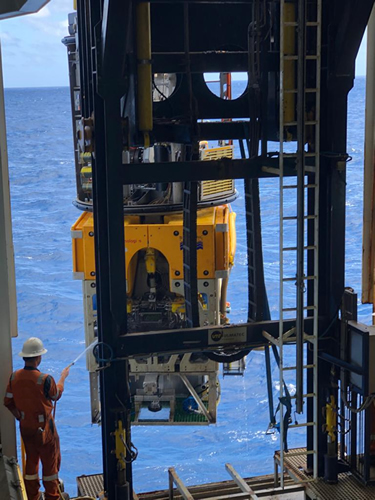 Source: Michael Stocks Source: Michael Stocks
| | ROV deployment from ISLAND PRIDE’s ROV hangar |
One of the six autonomous underwater vehicles (AUVs) on board of the ISLAND PRIDE was prepared for a survey mission to photographically map the trial area (0.1 km2) and parts of its surroundings before the test, and a complementary survey will be carried out after the test. This is important to compare the pristine condition of the seafloor with the post-impacted condition in which nodules, sediment and fauna have been removed from the seafloor in the directly affected area, and sediments have drifted and settled down in the surroundings by very slow near-bottom currents. Such mapping should give us an indication of the depth of the sediment layer that has been removed and the extent of redeposition on the nodule habitat in the surroundings. On Thursday, a highly complex 60-hour mission of the AUV was meticulously planned and the AUV sent off to a depth of 4500 metres. More than 200 000 overlapping high-resolution photos of the seafloor were obtained that will be stitched together for a detailed photomosaic of the test area. Early on Sunday, the AUV was sent on a new 40-hour mission to map the extent of the sediment plume produced by the collector using the multibeam echosounder and turbidity sensors attached to the AUV.
 MV ISLAND PRIDE in the front and MV NORMAND ENERGY behind, both ships placing the last oceanographic sensors on the seafloor before the start of the Patania II test
Source: Franky Peeters MV ISLAND PRIDE in the front and MV NORMAND ENERGY behind, both ships placing the last oceanographic sensors on the seafloor before the start of the Patania II test
Source: Franky Peeters
The ISLAND PRIDE allows simultaneous operations of multiple equipment as long as security distances are maintained between gear and cables at all times. Both ROVs can work side by side on the seafloor along with a third cable in the water that attaches the sub-sea basket to the vessel. With AUV operations occurring autonomously at the same time and with GSR carrying out deployment of their own moorings with oceanographic equipment in close proximity, accurate and careful 4D planning of missions has been an essential component of our work and a great challenge for all surveyors and scientists involved.
Sampling of sediment and the water column with our multicorer, boxcorer and CTD-rosette has been less successful so far. The rented Okeanus winch with a 6000-m-long coaxial cable, which was sourced by the ship operator as part of the charter, has functioned poorly up to now – leading to excessively long deployment times and a significant loss of deployment time. On Saturday and Sunday, technicians from crew and science joined forces to repair the level wind, which was causing most of the malfunctioning. Sunday afternoon we successfully tested the winch and we are now confident that we can make up for some of the sampling deficiencies during the upcoming week.
On Saturday evening at 18:00 hours local time, all our sensors had been successfully deployed on the seafloor and the NORMAND ENERGY planned to deploy Patania II to start the 3-day mining test in the Belgian contract area. However, electrical issues with the hydraulic pressure unit postponed the deployment until Sunday, 14:00 hours. Nevertheless, it was a milestone action for many of us who have been involved in this project for the last four years. Patania II is now harvesting nodules from the seafloor. It will be very exciting to watch the development of the plume during the coming week through the eyes of our ROV cameras, AUV multibeam and turbidity sensors, water sampling with the CTD and through the acoustic and optical readings of our plume sensor network on the seafloor.
So let’s hope Patania II can make her tracks and we get a good three-dimensional idea of sediment plume development!
Annemiek Vink
|
|
MiningImpact Expedition Logbook, April 16, 2021 Blog #4: A marine expedition on hold: COVID-19
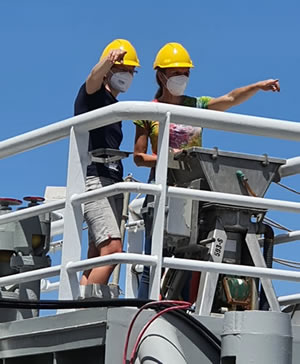 Planning on deck of the MV ISLAND PRIDE
Source: BGR Planning on deck of the MV ISLAND PRIDE
Source: BGR
The tests of GSR’s Patania II were planned to occur two years ago with a simultaneous independent monitoring from the German Research Vessel SONNE, all in the framework of the MiningImpact project. The technical failure of the power and communication cable to the nodule prototype collector quickly changed the situation and Patania II never reached the deep seafloor. It was a great disappointment to the technical engineers of the collector, but particularly also to the scientists who had transported their equipment across oceans and were ready to go. Even the policy and regulation makers of the ISA outed their disappointment, as they had set their hopes high for improved scientific guidance for the development of their recommendations, standards and guidelines in the middle of a time in which exploitation regulations were being drafted for the first time.
BGR identified the situation as having great potential for repetition and decided to integrate the monitoring of GSR’s newly planned collector tests into its exploration programme and strategy. New dates were set: October/November 2020. MiningImpact partners were invited to join the expedition. A tender for ship charter was published in early March 2020 and interested parties were identified. The cruise was to be called MANGAN 2020. But then, all this activity came to a screaming halt: COVID-19 reached us and the first lock-downs stifled all forward planning. The day we had to call off our planning still remains vivid in my memory.
Many people told me to give up the idea – there would be more tests planned by other companies in the future. But that wasn’t the point. MiningImpact with all its expertise would not be accessible anymore, and to me it was clear that this would be a real loss for Germany’s and Europe’s professional input to applied deep-sea research and international environmental regulation. Together with GSR and MiningImpact, we identified a last possible timeframe for the project: April/May 2021. We were hopeful that by then, the pandemic would have long reached its peak and gone.
Nothing less was true. You could say that COVID-19 influenced the logistics of this cruise at all levels. We had loads more work and much greater uncertainties than any expedition I have been involved in so far. Working with all the MiningImpact partners from 10 institutes and 6 countries didn’t make it easier. We had to develop an exclusive COVID-19 outbreak management plan just for this expedition that needed to fulfil both the expectations of all our partnering institutes and those of the ship and its operator. I will refrain from mentioning how many discussions and document versions we had, with no optimal solution to suite everyone.
I have also never carried out so many risk assessments before. For this expedition, container transports and travel issues for the USA or surrounding (transit) countries were identified to be the main risks or potential show-stoppers for the project. Exactly those caused major headaches during the preparation phase. The transports of eight containers with scientific equipment from Hamburg suffered more than four weeks of delay due to cancelled container ship departures, delays, reduced availability of labour in ports, and severe congestion of container ships in and around US ports. Due to the US travel ban for people coming from Schengen countries, applying for visas for the USA was a tedious process and visas were only issued just days before our scheduled flights to Los Angeles. Two Portuguese colleagues didn’t obtain visas on time and unfortunately couldn’t travel. Three further colleagues cancelled their participation at a time when finding replacement was impossible due to visa issues.
All participants had to spend 12 nights in a self-isolation hotel in San Diego before boarding the vessel, after having received another round of negative PCR-test results. On board, strict hygiene measures influenced our daily programme for another 10 days in order to further minimise the risk of a COVID infection on board to the greatest possible extent. I don’t need to tell anyone what it’s like to do heavy work on deck in the sun with a mask on… but in the interest of health and safety these measures were respected and adhered to.
And so here we are, in the Pacific with a slightly reduced team and after a 5-day delay in departure due to container delays – but very hopefully COVID-free and at last ready to start our research on board!
Annemiek Vink
|
|
MiningImpact Expedition Logbook, April 15, 2021 Blog #3: Polymetallic nodules: How they are formed and why we are interested in them
Polymetallic nodules, often simply called manganese nodules, cover many millions of square kilometres of the deep seafloor in water depths between 4000 and 6000 metres. Besides manganese, they also contain nickel, copper, cobalt and traces of other metals such as molybdenum, titanium and lithium, and are therefore of economic interest. The largest and economically most important deposit is located in the 5 million square kilometre Clarion-Clipperton Zone of the tropical North Pacific between Hawaii and Mexico. It is thus slightly larger than the total area of all countries in the European Union and Great Britain.
 Figure 1: Map of the manganese nodule belt between the Clarion and Clipperton fracture zones in the East Pacific. The two parts W1 and E1 of the German contract area are highlighted in red. The yellow areas are exploration areas of other contractors, blue-grey areas indicate "reserved areas", for which developing countries can obtain exploration contracts, and the green squares indicate Areas of Particular Environmental Interest (APEI), a kind of marine protected area. APEIs form a network of large no-mining zones that are intended to cover the full range of habitats, biodiversity and ecosystem functions
Source: BGR Figure 1: Map of the manganese nodule belt between the Clarion and Clipperton fracture zones in the East Pacific. The two parts W1 and E1 of the German contract area are highlighted in red. The yellow areas are exploration areas of other contractors, blue-grey areas indicate "reserved areas", for which developing countries can obtain exploration contracts, and the green squares indicate Areas of Particular Environmental Interest (APEI), a kind of marine protected area. APEIs form a network of large no-mining zones that are intended to cover the full range of habitats, biodiversity and ecosystem functions
Source: BGR
Manganese nodules are black-brown, roundish and mostly onion-like concretions with diameters of up to 15 centimetres, in exceptional cases even larger. They are formed by the precipitation of manganese and iron oxides as well as numerous minor and trace metals from seawater and pore water of the marine sediment. Precipitation occurs around a nucleus, which can be solidified sediment, an older nodule fragment or, more rarely, biological material such as a shark’s tooth. The nodules lie loosely on the seabed and they form slowly at a rate of 2 to 100 millimetres per million years.
 Figure 2: Manganese nodule (12 cm, cut in the middle) from 4400 metres water depth originating from the German license area in the Pacific Ocean
Source: BGR Figure 2: Manganese nodule (12 cm, cut in the middle) from 4400 metres water depth originating from the German license area in the Pacific Ocean
Source: BGR
An increasing demand for the above-mentioned metals due to continued global population and economic growth, as well as the technological transition from fossil to renewable energy sources and e-mobility, have brought potential mining of raw materials in the deep sea back into focus. Today, these metal raw materials are mined exclusively on land. There, they are associated with a number of environmental impacts and social problems, for example the clearing of rainforests, destruction of agricultural land, the consumption of large amounts of water, the input of pollutants and heavy metals from mining, as well as the forced relocation of indigenous peoples into surrounding areas. In addition, for some metals the majority of production comes from only one country. Often this supply derives from states with increased geo-political instability, e.g. cobalt from the Democratic Republic of Congo. Recycling can also only partially meet future supply needs, even if its efficiency is significantly increased. In order to meet the growing global demand, secure the supply for countries without raw materials and reduce the dependencies of such countries on monopolists for certain metals, state-owned contractors have been exploring mineral deposits in the deep sea for 20 years and private companies for about 10 years.
 Figure 3: Shark tooth from the Tertiary period. The tooth of a megalodon giant shark, extinct for about 2 million years, is overgrown by a manganese nodule
Source: BGR Figure 3: Shark tooth from the Tertiary period. The tooth of a megalodon giant shark, extinct for about 2 million years, is overgrown by a manganese nodule
Source: BGR
BGR holds an exploration contract for manganese nodule deposits in an area of 75,000 square kilometres in the eastern Pacific on behalf of the German federal government. BGR investigates the economic potential of extensive manganese nodule fields and carries out comprehensive environmental studies. Deep-sea mining could make Germany less dependent on resource-rich countries like Russia, China or the DR Congo.
However, deep-sea mining is the subject of controversial public debate. From a political point of view, securing unrestricted access to metal raw materials in the long term is of great importance for the production of various industrial products that we use every day. Critics, on the other hand, point above all to the vulnerability of a largely pristine ecosystem that should be protected from any form of interference. They are concerned about potential large-scale impacts of underwater mining. In addition to the removal of the upper centimetres of the seabed along with the nodules and the animals living in them, these include in particular the development of suspension clouds and adverse effects on the food chain.
Ultimately, a decision is required as to whether the metals for the human hunger for raw materials should continue to be extracted exclusively from conventional sources on land or, in the future, partly from the deep sea. Both mining operations will always be associated with environmental impacts - either on land, in our habitat, or at 4000 metres water depth, in the deep sea. To which extent industrial mining on the ocean floor would affect the deep-sea ecosystem in the Clarion-Clipperton Zone is a question we seek to answer with our MANGAN 2021 expedition.
With best regards from aboard the ISLAND PRIDE
Carsten Rühlemann
|
|
MiningImpact Expedition Logbook, April 14, 2021 Blog #2: MANGAN2021 – Meet the team
Deep-sea mining is a highly complex topic. Studying the potential environmental impacts of mining manganese nodules at the seafloor, therefore, requires an equally diverse group of people. Today, we would like to introduce you to the MiningImpact team on board and tell you a bit about their prospective tasks during the expedition.

| Annemiek Vink
Federal Institute for Geosciences and Resources (BGR)
Annemiek is interested in deep-sea mineral exploration, environmental management, marine geology, and marine biology. She is the chief scientist of the MANGAN2021 cruise. Her main tasks will be the coordination of activities, cruise planning, the deployment of equipment, moorings, and maybe some biological sampling if she finds the time. | 
| Matthias Haeckel
GEOMAR Helmholtz Centre for Ocean Research Kiel (GEOMAR)
Matthias is the project coordinator of the MiningImpact project. Onboard he will be responsible for coordinating research interests and arranging the daily work plan. He will also support the work of the biogeochemistry team. | 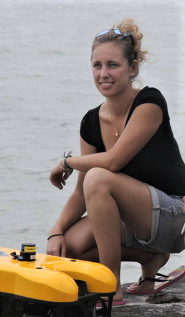
| Alizé Bouriat
French Research Institute for Exploitation of the Sea (IFREMER)
Alizé is interested in deep-sea biology. Onboard, she will participate in the processing, identification and sorting of megafauna, macrofauna, and meiofauna for the boxcorer and multicorer samplings. She will also be involved in carrying out biogeochemical sediment experiments. | 
| Batuhan Yapan
Max Planck Institute for Marine Microbiology (MPI)
Batuhan’s primary interest is microbial ecology. Onboard, he will take sediment samples for elucidating the structure of microbial communities in different environmental conditions. He will also conduct assays on microbial activity | 
| Carsten Rühlemann
Federal Institute for Geosciences and Natural Resources (BGR)
Carsten is interested in everything related to deep-sea minerals: Exploration at sea, environmental issues, legislation, and technical aspects. Onboard, he will assist and support the chief scientist with her work. Furthermore, he will take care of the CTD measurements (which stands for conductivity, temperature, depth) and sediment traps and support the plume monitoring team. The sediment traps are moored on the seabed for a certain period and catch the sinking particles. These data provide information on the planktonic species living in the sunlit upper water layer, bioproduction, and the amount and composition of inorganic matter. Regarding the planned collector test, the sediment traps will be used to determine the amount and particle size of suspended sediments. | 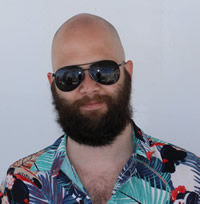
| Dennis Hagedorn
Federal Institute for Geosciences and Natural Resources (BGR)
Dennis is an electrical engineer. Onboard, he will mainly be responsible for maintenance, programming, and preparation of the equipment for the moorings (specifically sediment traps, water current and turbidity sensors, and the mechanical preparation of the mooring chain before deployment). Furthermore, he will install the SHDSL telemetry incl. deck station for the multicorer so that it can display images online. | 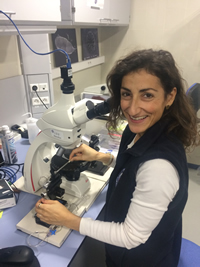
| Duygu Sevgi Sevilgen
Bridge group at Max Planck Institute for Marine Microbiology (MPI) and Alfred-Wegener-Institute Helmholtz Centre for Polar and Marine Research (AWI)
Duygu’s main area of interest is sediment biogeochemistry. She is a part of the MPI/AWI Bridge group for Deep-sea Ecology and -Technology. Together with her colleagues, she will assess the impacts of nodule mining on microbial communities and microbial community metabolism at the seafloor. With the support of the ROV team onboard, she will measure oxygen distribution in the top centimeters of the sediments directly at the bottom of the sea using delicate microsensors. Duygu will be in charge of calibrating the sensors and mounting them on the profiler, programming the operations, and supervising the ROV pilots during the deployments. | 
| Felix Janssen
Bridge group at Max Planck Institute for Marine Microbiology (MPI) and Alfred-Wegener-Institute Helmholtz Centre for Polar and Marine Research (AWI)
Felix is interested in sediment biogeochemistry. Together with colleagues from the MPI/ AWI Bridge group for Deep-sea Ecology and Technology, he will assess the impacts of nodule mining on microbe communities and their contribution to the conversion of organic matter at the seafloor. Microbes dominate biomass at the bottom of the deep sea. They are critical players in seafloor food webs and efficiently cycle organic carbon and nutrients. Together with Duygu, he will measure oxygen distribution in the top layer of the sediments directly at the seafloor. With a bit of modeling, those data are magically turned into rates of seafloor oxygen uptake – a bulk measure of total microbial community metabolism. | 
| François Charlet
Global Sea Mineral Resources (GSR)
François is the GSR representative on board the “Island Pride” vessel. His main interests are marine geology, geophysical survey, nodule resources, deep-sea exploration, environmental impact assessment, deep-sea harvesting technology. Onboard the Island Pride, he will be in charge of the communication between the GSR-chartered vessel “Normand Energy” and the “Island Pride” to align planning and simultaneous operation activities involving the GSR-pre-prototype vehicle Patania II with the scientific monitoring tools (AUV/ROV). | 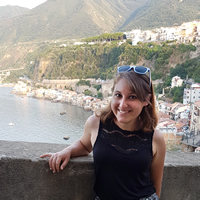
| Gabriella Luongo
Polytechnic University of Marche (UNIVPN)
Gabriella’s primary interest is ecology. Onboard, she will collect sediment samples pre and post-impact in the investigated areas to assess the environmental impacts of deep-sea mining. Subsequently, the samples will be processed to analyze the system’s trophic state (in terms of pigments and organic matter quantity, composition, and turnover), viral abundance, and viral production coupled with estimates of abundance and biomass of prokaryotic hosts. Furthermore, she will perform molecular analysis regarding microeukaryots diversity. Overall, these results will provide new insights into how deep-sea mining can modify organic matter content, virus-host interactions, and microeukaryotes diversity with downstream effects on the functioning of benthic deep-sea ecosystems. | 
| Henko de Stigter
Royal Netherlands Institute for Sea Research (NIOZ)
Henko is interested in marine geology and sediment dynamics. With his colleagues of the plume sensor team onboard the Island Pride, he will investigate the sediment plume stirred up from the seabed by the mining machine Patania II. How far and how high does the plume reach, how long does it take until the sediment has settled back to the bottom, and how thick or thin is the layer of redeposited sediment? He will use a fleet of sensors, some placed on the seabed, others towed on a cable from the ship, and some mounted on unmanned underwater vehicles, AUV’s. Knowledge of plume dynamics is needed for assessing the extent of deep-sea mining impact beyond the actual mined area. | 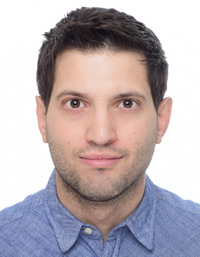
| Iason-Zois Gazis
GEOMAR Helmholtz Centre for Ocean Research Kiel (GEOMAR; DeepSea Monitoring Group)
Iason is interested in mapping the deep seabed, spatial predictive modeling, and manganese nodule research. Onboard, he will be involved in multibeam echosounder (MBES) seafloor and water column mapping, GIS analysis, and mission planning, and hydroacoustic sensors deployment for plume monitoring (e.g., ADCP, ADV). | 
| Jakob Barz
Max Planck Institute for Marine Microbiology (MPI) and Alfred-Wegener-Institute Helmholtz Centre for Polar and Marine Research (AWI)
Jakob is interested in microbiology. Onboard, he will be involved in sediment sampling with the multicorer for microbial diversity measurements, water sampling, and filtering from CTD, and in-situ pumps for microbial diversity measurements. | 
| Jochen Mohrmann
GEOMAR Helmholtz Centre for Ocean Research Kiel (GEOMAR)
Jochen is interested in AUV navigation, sonar, and computer sciences. He will be involved in sensor calibration and deployment, AUV dive planning, data processing, visualization, and management | 
| Jolien Goossens
Ghent University
Jolien is a biologist and is mainly interested in fish tracking. Onboard, she will be collecting samples from multicores, boxcores, and during ROV dives. Moreover, she will run an experiment on the food uptake by Holothurians on behalf of a colleague who unfortunately couldn’t join the cruise. She will also assist two theater producers based in Belgium in their research for a theater performance on deep-sea mining. | 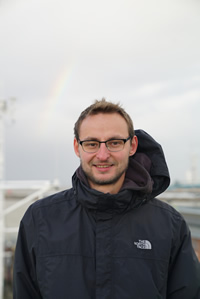
| Karl Heger
GEOMAR Helmholtz Centre for Ocean Research Kiel (GEOMAR)
Karl is interested in the technical challenges of ocean research. As part of the plume sensor team, he will set up a sensor array of over 40 sensors on the seafloor to map the sediment plume and its deposition that will be created during the mining trials. This includes configuring the sensors, overseeing their deployment and recovery via ROV, and finally making sure all the recorded data is safely stored. | 
| Katja Schmidt
Federal Institute for Geosciences and Natural Resources (BGR)
Katja is a geochemist. Her main interest is trace metal behavior in aqueous environments. Onboard, she will collect seawater and surface sediments from the seafloor for geochemical investigations. This also involves the sampling of the particle plume generated by Patania II, as one focus of this project is to study the mobilization and behavior of potentially toxic trace metals in such sediment plumes and their impact on fauna. While the tools to get the samples on deck will be operated by other people, her part will mainly be to split the samples into different aliquots, conduct treatments such as filtration and pore water extractions, and conserve them for detailed analyses back home. She will mainly work in the cool room at 4°C and the geochemistry laboratory. | 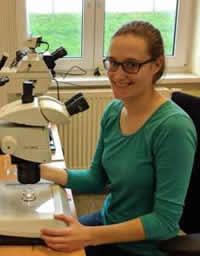
| Katja Uhlenkott
Senckenberg am Meer, German Center for Marine Biodiversity Research
Katja is interested in the distribution modeling of meiofauna and megafauna. Onboard, she will sample meiofauna with the multicorer. Moreover, she will collect epifauna and infauna samples with the boxcorer and collect and annotate megafauna with the ROV. | 
| Massimiliano Molari
Max Planck Institute for Marine Microbiology (MPI) – HGF MPG Joint Research Group for Deep Sea Ecology and Technology
Massi is interested in microbial ecology, specifically the microbial taxonomic and functional diversity and role of microbes in the elements cycle (carbon, nitrogen, metals, etc.). His main goal is to investigate the impact of GSR’s prototype collector on microbial diversity, activity, and abundance in water, sediment, and manganese nodules. He will mainly be involved in collecting samples from multicorer, CTD, and boxcorer to achieve this. He will also carry out subsampling for different microbial parameters (DNA, RNA, cells abundance) and an incubation experiment to assess microbial activity. | 
| Mirja Bardenhagen
Federal Institute for Geosciences and Natural Resources (BGR)
Mirja is a chemistry technician working in the field of marine resource exploration. She has been involved in the organisation of the cruise, specifically in the logistics. Onboard, she will take and preserve water samples. Subsequently, she will analyse the samples for trace metals in the home laboratories. | 
| Nils Maschmann
Oktopus GmbH (on behalf of GEOMAR)
Nils joins the research cruise as a technician. He will look after and operate the multicorer, the boxcorer and lend a helping hand when needed. | 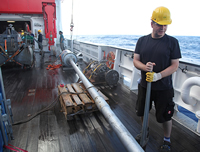
| Oliver Kefel
Federal Institute for Geosciences and Resources (BGR)
Oliver is a mechanic. Onboard, he will support the operation of the boxcorer and support other necessary mechanical work, e.g., with moorings. | 
| Sven Rossel
Senckenberg am Meer, German Center for Marine Biodiversity Research
Sven’s main area of interest is rapid biodiversity assessment using MADI-TOF mass spectrometry focusing on meiofauna. Onboard, Sven will be involved in the deployment of the multicorer. The multicorer will be used to collect and fix meiofauna samples for further analysis using MALDI-TOF MS, metabarcoding, and community analysis at the institute. Preparing the samples onboard will include megafauna sampling using the ROV, fauna annotations during ROV dives, preparation of passive samplers, sorting macrofauna samples, etc. | 
| Tanja Stratmann
Max Planck Institute for Marine Microbiology (MPI), Utrecht University
Tanja is interested in deep-sea ecology and biogeochemistry, in particular trophic interactions and food-web modeling. Onboard, she will be involved in deploying larvae pumps, deployment of amphipod traps, megafauna survey and sampling, deployment of nodule frames, and nodule collection from the boxcorer. | 
| Thomas Aigner and Michael Stocks
SWR/ ARD/ ARTE
Thomas (left) and Michael (right) will produce a film about deep-sea mining for television. They will film some of the work onboard and conduct interviews with the participants of the expedition. |
|
|
MiningImpact Expedition Logbook, April 11, 2021 Blog #1: Expedition MANGAN 2021: A challenging cruise with high expectations
There were many times in the last few months that we weren’t sure this was going to work out. What a crazy idea, trying to get two ships out synchronously into the Clarion-Clipperton Zone (CCZ) of the Pacific in the middle of a global pandemic! Why did we do it? Well, because it’s now or never.
BGR’s expedition MANGAN 2021 with the Norwegian multi-purpose vessel ISLAND PRIDE aims at independently monitoring and assessing the environmental impacts of in situ technical tests of a pre-prototype polymetallic nodule collector vehicle (Patania II) at a sub-industrial scale 1:4 that has been developed by the Belgian company Global Sea Mineral Resources (GSR). The environmental monitoring will be carried out in close collaboration with European research institutes from the JPI-O MiningImpact Consortium, who have been invited to join this campaign in a joint effort to obtain a sound scientific basis for the analysis and modelling of mining-related impacts. GSR has agreed to its activities being independently investigated and has worked closely with us to synchronise cruise schedules. These tests were planned to occur two years ago with a simultaneous monitoring from the German Research Vessel SONNE, but a technical failure of the power and communication cable to Patania II meant that the trials had to be called off. It was a blow to the project, which is only set to run until the end of February 2022. It was clear that, if we want to keep this cumulative European competence together and use it wisely, we would not have much time to loose. Even during COVID times… as long as feasible precautionary measures and risk mitigation strategies were in place.
 MV ISLAND PRIDE during mobilisation in the port of San Diego
Source: Thomas Aigner MV ISLAND PRIDE during mobilisation in the port of San Diego
Source: Thomas Aigner
The logistics of this cruise in the midst of the pandemic, starting and ending in San Diego (USA), have of course been challenging. The transports of eight containers with scientific equipment from Hamburg suffered more than four weeks of delay. Due to the US travel ban for people coming from Schengen countries, applying for visas for the USA was a tedious process and visas were only issued just days before our scheduled flights to Los Angeles. All participants had to spend 12 nights in a self-isolation hotel in San Diego before boarding the vessel, after having received another round of negative PCR-test results. The highlights of the day were the online preparatory web meetings that we held, as well as online sports and games sessions! On board, strict hygiene measures are being adhered to for a total of 10 days in order to further minimise the risk of a COVID infection on board to the greatest possible extent. Just a few more days and we can hopefully be confident that we’ve left the virus behind us.
 Deck of MV ISLAND PRIDE with stacked laboratory containers and scientific sampling equipment (boxcorer, multicorer, CTD-rosette, BoBo lander). Within the A-frame is a large sub-sea basket that will transport our hydro-acoustic and optical sensor platforms to the seafloor
Source: Thomas Aigner Deck of MV ISLAND PRIDE with stacked laboratory containers and scientific sampling equipment (boxcorer, multicorer, CTD-rosette, BoBo lander). Within the A-frame is a large sub-sea basket that will transport our hydro-acoustic and optical sensor platforms to the seafloor
Source: Thomas Aigner
During this six-week cruise, we intend to intensively monitor two collector tests that will take place in the Belgian and German contract areas of the CCZ, respectively. This is the first sub-industrial scale mining vehicle ever to be tested. For the monitoring of environmental change on and around the seafloor, state-of-the-art tools such as two remotely-operated vehicles (ROV), an autonomous underwater vehicle (AUV), in situ oxygen profilers and experiment chambers, in situ pumps and fifty inter-calibrated hydro-acoustic and optical sensors for measuring the suspended sediment concentrations in the sediment plume will be deployed. 23 scientists from 8 institutes in Europe are on board to analyse the distribution and settling behaviour of the sediment plume whirled up by the collector, faunal changes across different size classes, biogeochemical fluxes, changes in microbial turnover rates and functions, in-situ ecotoxicology, release of trace metals from the suspended sediment plume and noise emissions by the collector vehicle. We hope that the results of this campaign will greatly contribute to the development of robust environmental standards that are required by the International Seabed Authority as an essential component of its future exploitation regulations, also known as the Mining Code.
 A typical polymetallic nodule field in the German contract area at 4100 m water depth
Source: BGR A typical polymetallic nodule field in the German contract area at 4100 m water depth
Source: BGR
The MV NORMAND ENERGY with the Patania II collector on board is already in the Belgian contract area with technicians and scientists from GSR and Massachusetts Institute of Technology (MIT) on board. Due to the container delays, our departure from the port of San Diego was delayed by 5.5 days. We are now sailing into the horizon in a south-southwest direction to meet up with them and start our work as soon as we can. In the next few weeks, you will get to know us all better and understand what we are doing on board, how and why we do it and why research and monitoring in the deep sea is so challenging and exciting.
So watch this space!
Greetings from ISLAND PRIDE
Annemiek Vink, Matthias Haeckel
|






























































































